Ampersand Annual Report









Welcome to the Department of Art & Archaeology’s new publication, Ampersand, an annual report that provides a snapshot of the department’s activities and accomplishments over the previous year. The ampersand symbol originated in ancient Rome, as a ligature, or joining, of two letters that form the word “et,” Latin for “and.” The symbol acquired its name, “ampersand,” much later, in the nineteenth century, through a condensation of the phrase “and per se and,” tacked onto the end of the alphabet by Englishspeaking schoolchildren who were taught that “and” was the twenty-seventh letter of the alphabet, as in “w, x, y, z, and per se and.” Today, the ampersand appears in print around the globe and across myriad languages. In this way, the “ampersand” embodies in both its history and its meaning certain of the department’s essential characteristics, including its chronological and geographical breadth and its dedication to capacious and wide-ranging scholarly inquiry and to the cultivation of an inclusive and welcoming community. The symbol itself, with its encircling loops and upward-inclining extremities, connotes connection and convergence as well as dynamism, multiplicity, and transformation.

Our return to campus after a year of remote teaching and learning came with excitement as well as adjustment as we settled into our temporary home in Green Hall and navigated changing COVID protocols and the inevitable, if productive, challenges of reentry, all of this against the backdrop of a volatile political landscape. Students, faculty, and staff met these challenges with admirable energy and creativity and excelled in their work. Again, the buzz
of conversation and curiosity filled our classrooms and studios. Much good news came our way this year, including the promotion of Anna Arabindan-Kesson and Carolina Mangone to the rank of Associate Professor, the promotion of Bridget Alsdorf to the rank of Full Professor, and the promotion of Dora Ching to Deputy Director of the Tang Center for East Asian Art. Additionally, we are thrilled to welcome Professor Tina Campt to the department, and we look forward to the collaborations inspired by her joint appointment with the Lewis Center for the Arts and the LCA’s Program in Visual Arts, superbly helmed by Jeff Whetstone.
This year also saw the retirement of Professor Anne McCauley, the David Hunter McAlpin Professor of the History of Photography and Modern Art, who joined the faculty in 2002. Professor McCauley helped make Princeton an essential destination for the study of the history of photography. In doing so, she built on the important work of her predecessor, the late Peter Bunnell, the inaugural McAlpin Professor, who passed away in September 2021.
As Chair, I am confident that the department will continue to thrive as it advances its work and plots new directions going forward, and I am grateful to be a part of the art & archaeology community. Please enjoy the inaugural issue of Ampersand

Sincerely, Rachael Z. DeLue, Chair
Christopher Binyon Sarofim ’86 Professor in American Art Faculty, Effron Center for the Study of America

 Patricia Blessing at work in a stone carving work shop led by Professor Sam Holzman as part of her course ART 401. (Photo/Basile Baudez)
Patricia Blessing at work in a stone carving work shop led by Professor Sam Holzman as part of her course ART 401. (Photo/Basile Baudez)
Bridget Alsdorf’s Gawkers: Art and Audience in Late NineteenthCentury France (Princeton University Press, 2022), explores artists’ and writers’ representa tions of the seductions, horrors, and banalities of Parisian street life through the eyes of curious onlookers and the impact of this motif on late 19th-century French culture. Alsdorf taught the graduate seminar ART 564: “Art and Nihilism: Goya and Blake,” along with two undergraduate seminars: ART 451: “The Artist as Idea,” co-taught with Carolyn Yerkes, and ART 345: “Art and Knowledge in the Nineteenth Century,” co-taught with Rachael DeLue. She served as a Faculty Fellow in the Princeton Society of Fellows in the Liberal Arts, and joined the Committee on European Painting and Sculpture at the Art Institute of Chicago. Over the summer, she spent time in Denmark and continued learning Danish for a new book on Scandinavian art.
Anna Arabindan-Kesson was awarded tenure in 2022. Selected as the Terra Foundation Rome Prize Fellow by the American Academy in Rome, she was also appointed the inaugural Senior Research Fellow at the Art Gallery of Western Australia. She held the Tomás Harris Visiting Professorship at University College London, where she presented lectures and papers throughout the year based on new research on art and medicine in the British Empire and gave book talks about her monograph Black Bodies, White Gold (Duke University Press, 2021). With support from the department and University as well as her dedicated team of graduate and undergraduate students, ArabindanKesson’s digital humanities project, Art Hx, continued to grow. The public program on “Curative Spaces” ended in a fascinating symposium (artandcolonialmedicine.com); for the coming year, the theme will be “Policy.” Arabindan-Kesson also continued to publish articles and essays on 19th-century Black diaspora art, contemporary artists, and art and medicine.
Nathan Arrington published an article examining the relation ship of his archaeological site to river lands: “The Classical City on the Molyvoti Peninsula (Aegean Thrace): Landscape, Urban Development, and Economic Networks,” in The Riverlands of Aegean Thrace, edited by Eurydice Kefalidou (Propylaeum, 2022).
Anna Arabindan-Kesson was one of four campus-wide faculty members to receive the Graduate Mentoring Award from the McGraw Center for Teaching and Learning at the Graduate School’s Hooding ceremony in spring 2022. Graduate students nominate faculty whose investment in their students’ intellectual, profes sional, and personal growth stands out. Along with faculty, they also serve on the committee that selects the winners. The award honors one faculty member in each academic division (engineering, humanities, natural sciences, and social sciences) and includes a $1,000 prize and commemorative gift.
Appointed in both the art & archaeology and African American studies departments, ArabindanKesson was singled out for her passionate interest in her fields. “Her enthusiasm for art history is infec tious,” one student said. “Anna has empowered me to articulate my own ideas in relation to the field and has encouraged me to be bolder about my research.” Another student valued her commitment in reviewing several drafts of his essay, guiding him “to develop this nugget of an idea into a fully-fledged article that is rigorous but also broadly accessible.”
Bridget Alsdorf, Gawkers: Art and Audience in Late Nineteenth-Century France
He also wrote the entry entitled “Greek Funerary Art” for the Oxford Classical Dictionary, the standard reference work for the field. A dozen other articles and chapters are in various stages of production and review. Arrington taught a new graduate reading course on Greek sculpture and led the inaugural
Particularly pronounced during the pandemic was the support and personal investment Arabindan-Kesson offers her students. One student praised ArabindanKesson’s finding the time to engage with him while she was on leave in a different time zone, saying “she still managed to find time to connect with me and ensure I was taking the most helpful courses and tackling projects from productive angles.” Summing up the general sense of support Arabindan-Kesson offers her students, another student said: “Her passion for educa tion and mentorship is reflected in the community of care that she created in her classroom.”
graduate reading group for Classical and Hellenistic Studies. He finished his terms as Director of Undergraduate Studies, Director of the Program in Archaeology, and President of the Princeton Chapter of the Archaeological Institute of America. Outside of Princeton, Arrington chaired the award jury for the College Art Association’s Arthur Kingsley Porter Prize. He has joined the editorial board of the journal Hesperia and was elected to the Excavation and Survey Committee of the American School of Classical Studies at Athens.
For the 2022–23 academic year, Arrington was awarded a fellowship from the Alexander von Humboldt Foundation, during which he will continue to develop a book project on touch and Greek art.
Basile Baudez published Inessential Colors: Architecture on Paper in Early Modern Europe (Princeton University Press, 2021) and presented it at the University of Edinburgh and the Iuav University of Venice. He contributed the chapter “Architecture and Interiors” in Volume 4: A Cultural History of Color in the Age of Enlightenment of the edited volumes A Cultural History of Color (Bloomsbury, 2021) and the essays: “Les institutions de l’architecture sous le Consulat
et l’Empire: gérer l’héritage révolutionnaire en régime monar chique” and “L’enseignement de l’architecture à Paris sous le Consulat et l’Empire” in Bâtir pour Napoléon: une Architecture FrancoItalienne (Archivio del Moderno, 2021). He presented his in-progress book project, Fabric and the City: Textile in 18th-century Venice, at the Ca’Foscari University of Venice, the Complutense University of Madrid, and the Princeton Talks series. With Stefana Parascho and Lauren Dreier from the School of Architecture, Baudez co-curated Robotic Lacing: Lace in Space on campus. In spring, he taught the communityengaged course “The Architecture of Confinement” and co-organized with Victoria Bergbauer (Ph.D. candidate in history) a related, two-day conference.
On sabbatical in 2022–23, Patricia Blessing was appointed Senior Fellow at ANAMED, the Koç University Research Center for Anatolian Civilizations in Istanbul. Her second book, Architecture and Material Politics in the Fifteenthcentury Ottoman Empire, was published by Cambridge University Press (2022). She presented her work via Zoom in conferences organized by the municipalities of Konya and Istanbul, in the Islamic studies lecture series at Rutgers University Newark, and in person at the conference organized by the Index of Medieval Art: “Fragments, Art, and Meaning in the Middle Ages.” Blessing taught ART 401: “Introduction to Archaeology” and ART 403: “Sensory Spaces, Tactile Objects: The Senses in Art and Architecture.” Together with Richard P. McClary (University of York, United Kingdom), Blessing received a British Academy/Leverhulme Small Research Grant for a project on Seljuq palatial architecture.
Rachel Z. DeLue published essays on the topics of the German naturalist Alexander von Humboldt and the Anthropocene as well as on the representation of indige nous cultures in Anglo-American archaeology in the first half of the 19th century. She also published: “ ‘Things not tangible’: Portraits, Sitters, and the Supernatural” in Supernatural America: The Paranormal in American Art (University of Chicago Press, 2021) and “Revenant Painting” in Andrew Wyeth: Life and Death (Colby College Museum of Art/ Delmonico, 2022). At the College Art Association annual meeting, Professor DeLue delivered a talk entitled “Painting Blind: John Singer Sargent’s Gassed.” In fall, she co-taught American Studies
101: “America Then and Now,” the gateway course for American Studies, with Professors Anne A. Cheng (English) and Yaacob Dweck (history), and in spring, she co-taught the seminar, ART 345: “Art and Knowledge in the Nineteenth Century,” with Professor Bridget Alsdorf.
Anne McCauley, the David Hunter McAlpin Professor of the History of Photography and Modern Art in the Department of Art & Archaeology, transferred to emeritus status on July 1, 2022, after 20 years of teaching at Princeton. McCauley’s commitment to giving students firsthand experience of art and its methods through local exhibitions and Art Museum holdings was apparent in the exceptional breadth of courses she taught. In spring 2022, McCauley concluded her teaching tenure with a lecture based on a book project entitled “Alvin Langdon Coburn, the Great War, and the ‘World’s First Abstract Photographs’,” in which she explored abstract photographs Coburn made in reaction to World War I, using a device he devised with American poet Ezra Pound.
“The originality, richness, depth, and scope of Anne’s scholarship have shaped and sustained the history of photography at Princeton as a field.”
Professor Rachael Z. DeLue
McCauley’s first book, A.A.E. Disdéri and the Carte de Visite Portrait Photograph (Yale University Press, 1985), set the tone for the impactful body of work which was to follow. She elaborated big picture ideas about the nature and capacity of photography, its social contexts, its relationship to other media, and its influence on significant artists. Her subsequent publications addressed subjects as varied as fashion photography, comics and caricature, portraiture, pictorialism, spiritualism, the female nude, amateurism, racial prejudice in images of San Francisco’s Chinatown, and figures such as Thomas Eakins, Henri Matisse, Man Ray, Marcel Duchamp, Charles Aubry, Edward Steichen, Alfred Stieglitz, Paul Kelpe, Raymond Jonson, and Catherine Wagner.
“The originality, richness, depth, and scope of Anne’s scholarship have shaped and sustained the history of photography at Princeton as a field,” said Professor Rachael Z. DeLue. “Her work illuminates the decisive role played by
photography in the history and development of the fine arts and modern visual culture more broadly.“
McCauley grew up in Burlington, North Carolina, where her father’s family had lived since the 1770s. She earned her B.A. at Wellesley and her Ph.D. from Yale University. Her first teaching position was at the University of New Mexico in Albuquerque, followed by the University of TexasAustin in 1981, where she met her husband, Thomas Ferguson, Princeton Class of 1981. In 1988 they both took tenured positions at the University of Massachusetts-Boston. McCauley joined the art & archaeology department at Princeton in 2002. Her daughters, Louisa and Chloe, spent countless hours with McCauley in museums as children and accompanied her on research trips to France. Both are Princeton graduates.
For several years, McCauley served as the director of undergraduate studies and was a Faculty Fellow at Rockefeller College; she continues to work with several Ph.D. students as they pursue completion of their dissertation projects. She is an honorary member of the Royal Photographic Society, and her research has been supported by grants and fellowships awarded by the J. Paul Getty Museum, the Smithsonian, the American Council for Learned Societies, the Massachusetts Foundation for the Humanities, and the National Endowment for the Arts.
Curiosity and engagement with her field continue to guide McCauley’s research in retirement. She is currently working with Gary van Zante, curator of the MIT Museum in Cambridge, on a book on Minor White’s career at MIT. A short essay on a work by Hippolyte Bayard in the J. Paul Getty Museum’s celebrated Bayard album is also underway.
Brigid Doherty’s research in 2021–22 included a contribution to the catalogue for the exhibition Face à Arcimboldo at the Centre Pompidou-Metz, and a lecture on Heinrich Wölfflin’s writings on Raphael at the University of Toronto. In the fall, she taught a new Freshman Seminar, “A Portrait of the Artist As...” and co-taught, with Spyros Papapetros, a new interdisciplinary Humanities seminar, “Empathy and Alienation.” Each course aimed to enhance students’ experiences of the return to in-person courses with occasions for learning outside the classroom, including a field trip to New York City to see the Wooster Group’s acclaimed production of The Mother by Bertolt Brecht, and study sessions with works from the Art Museum in Firestone Library and the Museum’s offsite classroom. In Spring 2022, Doherty taught “Writing About Art: Rilke, Freud, Benjamin,” which brought together students with interests in literature, philosophy, psychoanalysis, and the visual arts.
Hal Foster continues to explore art and banality, beginning a new book on the subject in 2021–22. He remained a regular contributer to October, Artforum, and the London Review of Books. While on sabbat ical in 2022–23, Foster will teach at the University of Paris in November and be a guest at the American Academy in Rome from February to April.
Samuel Holzman delivered the Reunions Lecture: “New Archaeological Discoveries on Samothrace” on the stoa in the Sanctuary of the Great Gods on the Greek island of Samothrace. An article on new discoveries at the stoa was accepted for publication in the Journal of the Society of Architectural Historians. American Excavations Samothrace resumed fieldwork in the summer with a new focus on an architectural study of the ancient city’s fortification wall; Holzman hosted Nathan Arrington and his students there in July. Holzman’s book chapter about the Hellenistic architect Hermogenes appeared in Building the Classical
World: Bauforschung as a Contemporary Approach (Oxford University Press, 2022) and he gave a talk on the topic at the University of Pennsylvania. He was architec tural consultant for Athens Reborn: Acropolis a virtual reality tour which can be viewed on the Yorescape app. After co-teaching ART 102: “Introduction to the History of Architecture,” Holzman and Basile Baudez visited the Veneto, making a pilgrimage to the buildings of Andrea Palladio and Carlo Scarpa.
Thomas DaCosta Kaufmann was inducted into the Polish Academy of Arts and Sciences. His article “World Art History as a Conversation between the Prehistoric and the Contemporary” was published in Mix and Stir: New Outlooks on Contemporary Art from Global Perspectives, edited by H.P. Westgeest (Valiz, 2021); an intro ductory essay, “Patronage and Collecting in the Habsburg Empire c. 1700,” in The Belvedere at 300, ed. Christian Huemer, Vienna, is forthcoming later in 2022. He chaired one session and was respondent at another at the
Annual Meeting of the Renaissance Society of America held in Dublin. A keynote paper “Remarks on Art and Science” was read for him at a conference on the relation of the Humanities and the Sciences held in Riga, Latvia. Kaufmann has recently become active in conser vation, aiding in the successful defense of houses on Prospect Avenue, including art historian Erwin Panofsky’s first home in Princeton. His role as editor-in-chief of the Oxford Bibliographies in Art History continues.
In 2021–22, Beatrice Kitzinger served as Acting Director of the Program in Medieval Studies; the senior thesis colloquium included students working in classics, English, and history, along with art & archaeology. In January, she co-organized the conference “Power, Patronage, and Production: Book Arts from Central Europe in American Collections” (bookarts. princeton.edu) with Professor Jeffrey Hamburger (Harvard University) and Joshua O’Driscoll (Pierpont Morgan Library and Museum) in partnership with the Index of Medieval Art and the Morgan Library. The conference complemented the Morgan’s special exhibition, “Imperial Splendor” (themorgan.org/exhibitions/ imperial-splendor). Kitzinger’s article, “Wandalgarius’ Letters of the Law: Figural Initials and Book Culture in the Late Eighth Century” appeared in the Zeitschrift für Kunstgeschichte in the fall.
With Professor Jennifer Davis (Catholic University of America), Kitzinger presented a paper at the Fondazione Centro Italiano di Studi sull’Alto Medioevo, Spoleto.
Michael Koortbojian is currently preparing a monograph, The Representation of Relief in GraecoRoman Art. A Problem of Form and its Historiography for publication by De Gruyter Verlag. He will co-teach, with Professor Branko Glisic (civil and environmental engineering) a new course in fall 2022, ART 408: “Historical Structures: Ancient Architecture’s Materials, Construction and Engineering,” which will include a class trip to Rome.
Carolina Mangone was promoted to associate professor in April. Work on her new book examining the creation and reception of Michelangelo’s unfinished sculptures continues to progress. She was invited to speak on this topic at the Center for Italian Studies at Stony Brook University and gave a related talk, “Relief by Design: Michelangelo Between Marble and Paper,” at the Renaissance Society of America conference in Dublin. Continuing her interest in Michelangelo’s afterlife in Counter-Reformation art, she also co-published, with Jonathan Unglaub (Brandeis University), the essay “Guercino’s Saint Petronilla: Saintly Body, Michelangelo, and
Chika Okeke-Agulu joined the distinguished group of fellows world-wide who make up the UK’s national academy for the human ities and social sciences. The British Academy, founded in 1902, is a scholarly fellowship, a funding body for research in the UK and internationally, and a forum for debate and engagement.
The designation of Corresponding Fellow is awarded to scholars who have “attained high international standing in any of the branches of study which it is the object of the Academy to promote.” Jointly appointed in the art & archaeology and African American studies departments, Okeke-Agulu is recognized for his work in modern and contemporary African and African diaspora art; classical and traditional African Art; postcolonial theory and art criticism; and art and politics.

New St. Peters,” in Art History (2022).
As a teacher, she enjoyed giving a new course titled ART 435: “Bernini’s Women,” which explored the charged interplay of touch, desire, eroticism, and violence that animates his female bodies. It was also a plea sure to resume co-teaching in the Western Humanities Sequence, for which she will lead students through Rome in October 2022 with her colleague Moulie Vidas (religion).
Chika Okeke-Agulu published, El Anatsui: The Reinvention of Sculpture (Damiani, 2022) and African Artists: 1882 to Now (Phaidon, 2021). He gave keynote and named lectures at the University of Bayreuth, Africa Institute at Sharjah, Brown University, and the University of Michigan. In May, Okeke-Agulu
“This iteration of ‘The Japanese Print’ turned out to be one of the most satisfying teaching experiences of my career. For a variety of reasons, the seminar took place at an irregular time, from 7:30 to 10:20 p.m., and to study the prints, we had to travel to the Museum’s offsite classroom. Students did not balk at the evening time. Their energy fed me, and the unusualness of having meaningful discussions about prints late into the evening lent a special aura to our joint endeavor.”
—Andrew Watskyparticipated in the Oxford Union Debate, University of Oxford.
He was elected Corresponding Fellow of The British Academy, was appointed Slade Professor of Fine Art, University of Oxford (2022–23), and joined the advisory board of Edo Museum of West African Art (Benin City). With four students from his African Photography seminar, he is organizing the first U.S. museum survey of the photographer Samuel Fosso at Art on Hullfish, opening on November 17, 2022. He continues to work on the Sharjah Biennial 15, taking place in February 2023, as a member of the curatorial team.
In residence as the Clark/Oakley Humanities Fellow at the Clark Art Institute, Irene Small devoted the year to her book manuscript, The Organic Line: Towards a Topology of Modernism. She presented aspects of the book for the Annual Robert Rosenblum Lecture at the Guggenheim Museum, the Bettman Lecture at Columbia University, and in lectures for the Kunstinstituut Melly in Rotterdam, Netherlands, and the Courtauld Institute as well as the Research Center for Transnational Art, Identity, and Nation (TrAIN) in London.
She gave the Annual Stanley and Pearl Goodman Lecture on Latin American Art at the NSU Art Museum in Fort Lauderdale titled “Plasticity and Reproduction: Tarsila’s A Negra” and participated in the MoMA workshop, “Matters of Fact: The Concrete and the Conceptual in 1970s Latin America.”
Small looks forward the 2022–2023 year as acting co-director of the Program in Media and Modernity.
Cheng-hua Wang Cheng-hua Wang published two peer-reviewed articles in Handbook of the Colour Print in China 1600–1800 edited by Anne Farrer
and Kevin McLoughlin (Koninklijke Brill NV, 2021): “Commemoration and Celebration in the Printed Cityscapes of Suzhou,” and “Production and Commoditisation of Suzhou Single-Sheet Prints in the Early and Mid-Qing Dynasty with a Special Focus on Cityscapes.” She also submitted a research article and a catalogue essay. The latter, on print culture and urban life in 18th-century Suzhou, is for the exhibition Treasures from the Lower Yangzi Delta that will be held at the Cleveland Museum of Art in fall 2023. In addition, Wang gave three talks at the Institute for Advanced Study, UCLA, and National Taiwan Normal University related to her book manuscript, with the working title Up the River of Time: Qingming Shanghe as Painting Tradition from Song to Qing China. In terms of travel, the highlight of the year was a field trip to Taiwan. After a lapse of three years, she was finally able to conduct research there and to see informative exhibitions.
Having participated in his share of Zoom lectures and symposia, the highlight of Andrew Watsky’s year was returning to in-person events. In the fall, he taught ART 425: “The Japanese Print,” an undergraduate seminar rooted in close study of the Princeton University Art Museum’s holdings of 18th- and 19th-century woodblock prints; with the Museum under construction, the course entailed weekly bus trips to the Museum’s offsite classroom to work with the actual prints. (For more, see “Art Matters,” Princeton University Art Museum Magazine, Summer 2022). As director of the Tang Center for East Asian Art, Watsky convened the international sympo sium, “Connecting Dunhuang: Sites, Art, and Ideas along the Silk Road(s),” which brought to campus eleven speakers from around the
world with hundreds in the audi ence, in-person and online.
Having spent much of the past year researching a new book entitled Siegelands, Carolyn Yerkes is looking forward to teaching a seminar related to this material in spring 2023. She recently published an article on 17th-century echo chambers “The Heptaphonon and the Architecture of Echoes” and enjoyed co-teaching ART 451: “The Artist as Idea” with Bridget Alsdorf in spring. As of fall 2022, she serves as the department’s Director of Graduate Studies.
Tina Campt was jointly appointed in the Department of Art & Archaeology and the Lewis Center for the Art’s Program in Visual Arts as the Roger S. Berlind ’52 Professor in the Humanities on July 1, 2022. Campt served as a visiting professor at Princeton in 2021–22, initiating cross-disciplinary collaborations among faculty, students, and visitors that resulted in a student exhibition, a

conversation with artist Cameron Rowland and scholar Saidiya Hartman, as well as screenings and dialogues with award-win ning filmmakers John Akomfrah, Onye Anyanwu, Khalil Joseph, and Bradford Young. Campt will teach courses in contemporary art and theory, film and media, gender and sexuality studies, vernacular photography and the archive, the visual culture of the Black diaspora, and Black visuality and the racial and sexual politics of viewing and visibility. Starting in the spring, she will launch a new initiative at Princeton, The Collaboratorium: A Studio for Radical Aesthetics.
Allen R. Adler, Class of 1967, Distinguished Curator and Lecturer Ronni Baer taught ART 487, a seminar on Rembrandt’s prints at the Princeton University Art Museum, in fall 2021. Her essay, “Murillo and the North,” has been published in the catalogue for the

exhibition, Murillo: From Heaven to Earth, which opened at the Kimbell Art Museum in Fort Worth, Texas, in September 2022. The article traces the impact of Murillo’s three northern patrons living in Seville on his art and highlights the conso nance between Murillo’s art and that of Flemish painter and printmaker, Michael Sweerts.
Deputy Director, Tang Center for East Asian Art Dora Ching continued to focus on the arts of the Silk Road(s) following the 2021 release of the nine-volume publication Visualizing Dunhuang: The Lo Archive Photographs of the Mogao and Yulin Caves (Princeton University Press). She organized “Connecting Dunhuang: Sites, Art, and Ideas along the Silk Road(s),” an international symposium held on April 22–23, 2022 that featured speakers from the United States, England, France, and Japan. Throughout the academic year, she also presented virtual lectures at the 92nd Street Y, “Current
Archaeology Live! 2022,” and the Kyoto National Museum, and taught ART 357: “Dunhuang: Buddhist Art and Culture on the Silk Road.”

Janet Kay was chosen as a 2022–23 Community of Practice Fellow in Diversifying Science and Engineering Curriculum, as part of an effort by the Council on Science and Technology to diversify STEM teaching. Kay’s research and teaching focus on the archaeological sciences for use in history and the humanities. She and Professor Helmut Reimitz (history) were recently awarded a seed grant by the Humanities Council for the “Environmental History Lab” in medieval studies, a program of seminars, undergraduate workshops, and related courses and activities that emphasize the importance of environmental history (broadly construed) for under standing the medieval past. Kay has an article on medieval mass graves and multiple burials forthcoming in Medieval Archaeology. In addition
Above Alan Stahl reviewing the Theodotou Collection of Byzantine coins (Photo/Kirstin Ohrt)
Below Silver Medal of Francesco Morosini (1628), from Patricia Brown’s essay in Artibus et Historiae (Photo © The Hunterian, University of Glasgow)
Below right Jean-Nicolas-Louis Durand, Maisons Persanes, Chinoises, Turques, Moresques, Gothiques &c, in Recueil et Parallèle des Édifices de Tout Genre Anciens et Modernes, pl. 47 (detail).
to finishing her monograph with Oxford University Press, she is working to co-publish research on the archaeology of religion in Roman Britain with several current and former Archaeology Certificate students.
Lucy Partman pioneered an experimental, transdisciplinary course called the “Looking Lab: Experiments in Visual Thinking & Thinking about Visuals,” the first course at Princeton to marry the visual arts and entrepreneurship. Students first learned the skills of “close looking,” then worked in teams designing new tools to help people engage with the visual world and each other. In recognition of her contribution to advancing
the Graduate School’s mission of elevating and expanding profes sional development, Partman was awarded the 2022 Clio Hall Award.
The most important addition to the Numismatic Collection this year, and indeed of the past several decades, was the purchase of the Theodotou Collection of 12,000 Byzantine coins. Together with the 6,000 coins in the Donald Collection acquired in 2017 and the existing collections of Firestone and the Princeton University Art Museum, this has made Princeton’s the largest collec tion of Byzantine coinage in the world. The purchase was supported by the Seeger Hellenic Center, as was the hiring of a post-doctoral scholar as cataloguer of the collec tion. In March, the FLAME (Framing the Late Antique and Medieval Economy) project hosted a major conference on campus, signaling its shift in focus from building the database at flame.princeton.edu to supporting scholarly research on the transition from ancient to medi eval coinage. Work on the coins found by the Princeton-led Antioch excavations of the 1930s also progressed to an online presence, with the newly-configured OCHRE Antioch site set up to combine scans of the Antioch archives in the Visual Resources Collection with images of objects in the Art Museum and of the coins in the Art
Museum and of the coins in the Numismatic Collection into an inter active tool for archaeological study.
Patricia Fortini Brown co-chaired two sessions on Venetian women artists sponsored by Save Venice at the annual meeting of the Renaissance Society of America in Dublin. In May, she traveled to Athens and the island of Aegina for the final group workshop of the “Mediterranean Palimpsests” research project (mcities.cyi.ac.cy). Her article entitled “The Other Francesco Morosini” was published in Artibus et Historiae no. 84 (XLII) (2021).
Starting the year by organizing a conference on the Early Modern afterlife of the Mausoleum of Halicarnassus, Desmond Kraege is developing this into a collective book project. He has recently published articles on anachronism in Étienne-Louis Boullée’s rein terpretation of Raphael’s School of Athens, and on the impact of garden theory on the introduction of non-visual senses into discourses on interior decoration. As part of his postdoctoral research project on 18th-century French attempts to classify the architecture of world civilizations, he is preparing an article on Jean-Nicolas-Louis Durand’s Recueil et Parallèle des Édifices de Tout Genre Anciens et Modernes (Paris, 1801). Other forth coming publications include essays on Hubert Robert’s reimagination of northern French sites and territories, and on the pictorial strategies developed in early travel publications on Athens.
Legendary photog raphy scholar and curator Peter Bunnell passed away in September 2021 after a lengthy illness.
Bunnell became the country’s first endowed chair in the history of photog raphy when he joined Princeton’s Department of Art & Archaeology in 1972 as the inaugural David Hunter McAlpin Professor of the History of Photography and Modern Art. Affiliated with the Princeton University Art Museum for over three decades, he was curator of photog raphy, Museum director from 1973 to 1978, and acting director from 1998 to 2000.
“During his career at Princeton, Peter Bunnell, through his teaching, curating, and collection building, played an essential role in making both the Department of Art & Archaeology and the Princeton University Art Museum leading centers for the study of the history and theory of photography,” said Rachael DeLue.
Bunnell’s interest in photography was shaped by American photographer Minor White, who taught Bunnell as an undergraduate at the Rochester Institute of Technology. Clarence H. White Jr., the son of noted American photog rapher Clarence Hudson White, mentored him at Ohio University, where he received his M.A. in fine arts in 1961, followed by an M.A. in art history from Yale University in 1965.
Before joining Princeton’s faculty, Bunnell worked at the Museum of Modern Art as a curator of photography and oversaw a number of groundbreaking shows, including “Photography into Sculpture” (1970). A Guggenheim Foundation Fellow in 1979, Bunnell was also an Honorary Fellow of the Royal Photographic Society.
From Princeton, Bunnell’s 1989 exhibit “Minor White: The Eye That Shapes” traveled to New York’s Museum of Modern
Art, the San Francisco Museum of Modern Art, and the Museum of Fine Arts, Boston. Bunnell was instrumental in developing Princeton University Art Museum’s collection, making it a vital center for research in 20th-century photography. Along with acquiring the archives of both Minor White and Clarence H. White, Bunnell was also a pioneering curator and collector of modern Japanese photography. In 2011, the Museum’s curator ship of photography was named in Bunnell’s honor.
“Peter Bunnell was a lifelong defender of photography as an art form,” said Anne McCauley, the David H. McAlpin Professor of the History of Photography and Modern Art, adding “He valued creative expression in all its guises and passed on his enthusiasm to his friends and students.”
Among the many volumes that Bunnell wrote and edited over the course of his long career are “Minor White: The Eye That Shapes,” which won the George Wittenborn Memorial Book Award of the Art Libraries Society of North America; “A Photographic Vision: Pictorial Photography, 1889–1923”; “Edward Weston on Photography”; “Aperture Magazine Anthology: The Minor White Years, 1952–1976”; and “Photography at Princeton,” which was published on the 25th anniversary of the establish ment of the Museum’s photography collection.
James Steward, Nancy A. Nasher-David J. Haemisegger, Class of 1976, Director, Princeton University Art Museum and Lecturer with the rank of Professor in Art and Archaeology.
“Peter taught, mentored and shaped generations of students, scholars, curators, and others. The stories of him bewitching students in the classroom, surrounded by orig inal works of art, are legion,” said James Steward, Nancy A. Nasher–David J. Haemisegger, Class of 1976, Director of the Princeton Art Museum and Lecturer with the rank of Professor in Art and Archaeology.
“No one did more than he to shape the field of photography or our collections at Princeton. He was also one of the kindest people you could hope to know.”
Behind the Scenes: Inside the Princeton University Art Museum
Caroline Harris, Veronica White
China’s Objects: Opulence and Innovation
Zoe S. Kwok
Archaeology as History Janet Kay
A Portrait of the Artist As… Brigid Doherty
An Introduction to the History of Art
ART 100
Basile Baudez
An Introduction to the History of Architecture
ART 102/ARC 102
Basile Baudez, Samuel Holzman
Looking Lab: Experiments in Visual Thinking and Thinking about Visuals
ART 106/VIS 106/ENT 106 Lucy Partman
Greek Art and Archaeology
ART 202/HLS 202/CLA 200
Nathan Arrington
Roman Art ART 203
Michael Koortbojian
Greek Architecture
ART 207/HLS 207/CLA 207/ARC 211
Samuel Holzman
Neoclassicism through Impressionism
ART 212 Bridget Alsdorf
Ten Essential Topics in Chinese Art and Culture
ART 218/EAS 238 Cheng-hua Wang
Professor Barber’s graduate seminar ART 535: “Technê: Making Art in Late Antiquity and Byzantium” convened in Athens, Greece in May 2022, thanks to funding from the art and archaeology and Hellenic studies departments. The trip included study days in the major collections of the city as well as visits to the monasteries of Hosios Loukas and Daphni. Princeton students Megan Coates, Mathilde Sauquet, Fatih Tarhan, and John White worked alongside Greek students from a parallel course that had been taught by a colleague in Athens, Professor Anastasia Drandakê of the National and Kappodistrian University of Athens. Together, the students studied the collections in the Benaki Museum; the following day, they met at Princeton’s Seeger Center for Hellenic Studies in Athens to present and discuss their research from the course of the semester.
Above Princeton and Athens students and faculty in a workshop at the Seeger Center in Athens.
Art and Power in the Middle Ages
ART 228/HLS/MED/HUM 228
Charlie Barber, Beatrice Kitzinger
Renaissance Art and Architecture
ART 233/ARC 233
Carolina Mangone, Carolyn Yerkes
Introduction to African Art
ART 260/AAS/AFS 260
Chika Okeke-Agulu
Mesoamerican Art
ART 267/LAS 267/ANT 366
Bryan Just
The Foundations of Civilization: the Art and Archaeology of the Ancient Middle East ART 296/CLA/NES 296
Deborah Vischak
Smelting was an iron-producing technique that began in the Iron Age and persisted through the Classical World and the Middle Ages to Colonial America. A smelting tradition persists in West Africa, where the unique type of iron it produces holds cultural importance. Andrew Welton (University of Florida), a medieval archaeologist specializing in early medieval Britain, led the daylong demonstra tion of medieval-style smelting as part of a guest lecture for the course “The Science of Roman History.” Hosted by the Environmental History Lab in Medieval Studies, the event was co-sponsored by the Department of Art & Archaeology, Program in Archaeology, Humanities Council, Council on Science and Technology, and the Department of Classics.
Background photo Drying the clay furnace. (Photo/ Matthew Delvaux)
Inset photo Students help load the furnace, while Professor Sean Silver (Rutgers) observes. (Photo/Janet Kay)
Lucy Partman created the new course

ART 106: “Looking Lab: Experiments in Visual Thinking and Thinking about Visuals,” which explores visual thinking practices from a range of real-world fields and applies them in entrepre neurial design. In this transdisciplinary course, students tested their assump tions about looking; examined the anatomy and physiology of vision; developed their looking muscles; prac ticed visual problem-solving strategies; and collaborated on new tools to help people engage with the visual world.
Hellenistic Art
ART 307/HLS/CLA 307
Michael Koortbojian
Arts of the Medieval Book
ART 311/MED/HUM 311
Beatrice Kitzinger
The Formation of Christian Art
ART 316/HLS 316/ CLA 213
Charlie Barber
World Art History
ART 323
Thomas DaCosta Kaufmann
Architecture of Confinement, from the Hospice to the Era of Mass Incarceration
ART 329/ARC 318/HIS 330
Basile Baudez
Egypt in the Pyramid Age
ART 340/NES 352/AFS 340
Deborah Vischak
Dunhuang: Buddhist Art and Culture on the Silk Road
ART 357/EAS 368
Dora Ching
Post-1945 African Photography ART 378/AFS 378/AAS 377 Chika Okeke-Agulu
Supply-side Aesthetics: American Art in the Age of Reagan ART 384/AMS 394
AnnMarie Perl
Ancient Egyptian Funerary Culture ART 398/CLA 398/NES 398 Deborah Vischak
Junior Seminar ART 400 Nathan Arrington Introduction to Archaeology ART 401
Patricia Blessing
Sensory Spaces, Tactile Objects: The Senses in Art and Architecture ART 403/NES 403/ARC 402/HLS 404
Patricia Blessing
The Japanese Print ART 425/EAS 425
Andrew Watsky
Hagia Sophia: The Politics of Built Space
ART 430/MED/HLS 430
Charlie Barber
Bernini’s Women ART 435 Carolina Mangone
The Invisible Renaissance: Science, Art, and Magic in Early Modern Europe
ART 439/HIS 453/ECS 439
Thomas DaCosta Kaufmann, Jennifer Rampling
Learning through Looking: Master Drawings
ART 442
Thomas DaCosta Kaufmann
The Artist as Idea ART 451/ECS 451 Bridget Alsdorf, Carolyn Yerkes
Seminar in Modernist Art & Theory: Alienation in Modern Art & Literature
ART 455/VIS 455/ECS 456
Hal Foster
Egyptian Architecture: The Monumental Landscape
ART 481
Deborah Vischak
Pathologies of Difference: Art, Medicine, and Race in the British Empire
ART 483/AAS 483/HUM 483
Anna Arabindan-Kesson
The Meaning of Armor
ART 484
Pierre Terjanian Rembrandt
ART 487
Ronni Baer
Art and Knowledge in the Nineteenth Century
ART 489/HUM 489
Bridget Alsdorf, Rachael Z. DeLue
Proseminar in the History of Art
ART 500
Hal Foster
Introduction to Historiography
ART 501
Thomas DaCosta Kaufmann
Graduate Seminar
ART 502
Andrew Watsky
Studies in Greek Architecture: Public Spaces
ART 504
Samuel Holzman
Greek Sculpture and Roman Copies
ART 518
Michael Koortbojian
Problems in Late Antique and Byzantine Art and Architecture: Technê
ART 535/HLS 535
Charlie Barber
Early Modern Architecture ART 547
Carolyn Yerkes
The Color of Monochrome Sculpture
ART 548
Carolina Mangone
Art and the British Empire ART 560
Anna Arabindan-Kesson
Art and Nihilism: Goya and Blake ART 564
Bridget Alsdorf
Seminar in Modernist Art and Theory: The Bathetic and the Banal
ART 565
Hal Foster
Art Production, Consumption, and Collection in Ming-Qing Suzhou ART 568
Cheng-hua Wang
Japanese Tea and the Visual Arts ART 574
Andrew Watsky
Textile Architecture ART 583 Basile Baudez
The Greek House ART 599
Nathan Arrington
Introduction to Pre-20th Century Black Diaspora Art
AAS 244/ART 262/LAS 244
Anna Arabindan-Kesson
Introduction to 20th Century African American Art AAS 245/ART 245 Chika Okeke-Agulu
Enter the New Negro: Black Atlantic Aesthetics AAS 341/ART 375
Anna Arabindan-Kesson
Writing About Art (Rilke, Freud, Benjamin)
GER 372/ART 342/ECS 384 Brigid Doherty
Art, Apartheid, and South Africa
AAS 411/ART 471/AFS 411 Chika Okeke-Agulu
Radical Composition VIS 424/ART 479 Tina Campt
Empathy and Alienation: Aesthetics, Politics, Culture HUM 450/ART 482/GER 450/ARC 450/ECS 450
Brigid Doherty, Spyros Papapetros
Problems in Ancient History: Naturalism and Anti-Naturalism CLA 547/PAW 503/HLS 547/HIS 557/ART 527
Michael Koortbojian
Students of Basile Baudez’s ART 329: “The Architecture of Confinement” visiting the Eastern State Penitentiary in Philadelphia. (Photo/Basile Baudez)
“In ‘A Portrait of the Artist As . . .’ we celebrated the return to in-person learning by exploring collaborative practices in interpreting works of literature and art. A highlight: our visit to the Princeton University Art Museum offsite classroom to discuss Study for Negro Sunshine #2 (2004), a newly acquired drawing by Glenn Ligon, and its critical engagement with Gertrude Stein’s ‘Melanctha’ (1909).”
—Brigid Doherty
Glenn Ligon, Study for Negro Sunshine #2, 2004, oilstick, coal dust, and varnish, 2021-231; Museum purchase, Laura P. Hall Memorial Fund (© Glenn Ligon, courtesy of the artist, Hauser & Wirth, New York, Regen Projects, Los Angeles, Thomas Dane, London, and Chantal Crousel, Paris; Photo/Paul Salveson)
Presentation by Suzie Hermán during the symposium “Hansards in the World,” Amsterdam (Photo courtesy of Suzie Hermán)
Brandon Green sees his work on the 3rd-century crisis of the Roman Empire reflected in the enduring pestilence, fresh economic instability, and renewed military aggression of 2022. In addition to continued progress on his dissertation, “Confronting the Past in the Critical Third Century,” Green organized a session at this year’s College Art Association of America (CAA) titled “Forwards and Backwards in Ancient Portraiture.” In March, he presented at the conference “Nerone e Adriano: Le arti al potere” with support from Hadrian’s Villa and the Ministero della Cultura. His essay on the topic, “Nero and Hadrian: Two Models of Philhellenism in the Age of Gallienus,” will appear in 2023.
As the Andrew W. Mellon fellow at the Rijksmuseum in fall 2021, Suzie Hermán worked on her
dissertation project “The Art World of the Hanse.” While there, she organized an event titled “Mobility and Cosmopolitanism: Books, Art, and Patronage” together with Ph.D. candidate at UT Austin, Namrata B. Kanchan. In spring 2022, she studied major works of 16th- and 17th-century cartography as an Explokart fellow at the University of Amsterdam and Allard Pierson Museum. In the framework of this fellowship, she gave a guest lecture to M.A. students of the University of Amsterdam. Together with Michael W. Zhang, Suzie organized Princeton’s Department of Art & Archaeology Graduate Symposium “Has Anything Changed? New Strategies and Adaptive Methodologies in Art History Since COVID-19.” In collaboration with Alex Collin, Ph.D. candidate at the University of Amsterdam, Suzie organized “Hansards in the World. Continuity and Discontinuity on
the Intellectual, Cultural, and Economic Frontiers of the Early Modern Hanse.”
In May 2022, Mai Yamaguchi successfully completed and defended her dissertation titled “Paintings, Bound: Printed Books of Pictures in Nineteenth-Century Japan.” Her dissertation examines how illustrated printed books played a role in disseminating image literacy to an audience beyond the elite in Japan. Yamaguchi joined the Minneapolis Institute of Art as the Andrew W. Mellon Assistant Curator of Japanese and Korean Art in summer 2021. In her first year, she curated two exhibitions, The Poetic Abstractions of Maki Haku: Prints from the Kimm-Grufferman Collection and 20 Dances: Japanese Calligraphy Then and Now, and organized the rotation of the permanent galleries.
Amelia Ames, “Senga Nengudi: Matter and Motherhood” (Chika Okeke-Agulu)
Silvia Gianolio, “Rheno-Mosan Treasure Bindings 1150–1200 and Their Histories: The Lives and Afterlives of a Type” (Charlie Barber and Beatrice Kitzinger)
James Miller, “Fossils for a Future Time: David Smith and the Sculpting of Traces” (Rachael DeLue)
Rhiannon Pare, “(Ad)dressing the Gods: Fashioning Identity Through the Divine in the Roman Empire” (Michael Koortbojian)
Ben Price, “Anarchist Art and Cultures of Science in Fin-de-siècle France” (Bridget Alsdorf)
Claire Sabitt, “How a Tool Became a Treasure: Luxury Scissors and Their Ornamentation in Early Modern Europe, c. 1500–1750” (Thomas DaCosta Kaufmann)
Emily Smith-Sangster, “Non-royal Identity as Expressed in Northern Upper Egypt During the New Kingdom” (Deborah Vischak)
Niels Henriksen, “Figure as Cultural Form: The Art and ‘Archaeology’ of Asger Jorn, 1947–1973” (Hal Foster)
Sol Jung, “Assembling ‘Korea’: Peninsular Arts in Sixteenth-Century Japan” (Andrew Watsky)
Ben Murphy, “Second-Order Images: Reflexive Strategies in Early Latin American Video Art” (Irene Small)
Lucy Partman, “William Rimmer: Teaching Art” (Rachael DeLue)
Ying Sze Pek, “Reality Expanded: The Work of Hito Steyerl, 1998–2015” (Brigid Doherty)
Carmen Rosenberg-Miller, “Representing Difference: Painting and Performance in the Art of JeanFrançois Raffaëlli” (Bridget Alsdorf)
Kimia Shahi, “Margin, Surface, Depth: Picturing the Contours of the Marine in Nineteenth-Century America” (Rachael DeLue)
Mai Yamaguchi, “Paintings, Bound: Printed Books of Pictures in Nineteenth-Century Japan” (Andrew Watsky)
Jakob Schillinger *21 was awarded the 2022 Jane Faggen, Ph.D., Dissertation Prize. His disserta tion, “Painting Machines: Martin Kippenberger, Michael Krebber, Oswald Wiener, and the Cybernetics of Living Media,” supervised by Hal Foster, examines post-conceptual painting in 1980s and early 1990s Cologne. Schillinger explores how artistic production was dispersed in the social milieu through forms such as delegation, collaboration or rumor by comparing the case studies of Martin Kippenberger and Michael Krebber. Kippenberger’s Büro (Kippenberger’s office) rendered the artist a corporation capable of outsourcing artistic operations to other artists. By way of a highly effective rumor, Krebber became famous by producing no work at all. Schillinger examines the autonomization of the artistic process evident in both case studies through historical and theoretical connections to Oswald Wiener’s cybernetic aesthetics and writings on dandyism from 1978–1982.

Celebrating the field of Islamic art’s re-entry into the Department of Art & Archaeology, Professor Patricia Blessing and Ph.D. student Fatih Tarhan hosted a book club in spring 2022 dedicated to showcasing the arts of the Islamic Middle East. Students and faculty throughout the university community participated, representing the fields of art and archaeology, history, classics, Near Eastern studies, and religion. The diversity of the participants contributed to a rich, thought-provoking and critical discussion. In addition to their connection with Islamic art, books were selected for their cross-cultural, cross-disciplinary insights and their handling of methodological challenges in art historical scholarship from the Late Antique to the Modern Period. To contextualize Islamic art, Wendy Shaw’s What is “Islamic” Art?: Between Religion and Perception (Cambridge University Press, 2019) kicked off the readings. This was followed by Ünver Rüstem’s Ottoman Baroque: The Architectural Refashioning of Eighteenth-Century Istanbul (Princeton University Press, 2019), investigating European Baroque style in 18th-century Istanbul. Simon O’Meara’s
One of the books read by the book club participants
The Ka’ba Orientations: Readings in Islam’s Ancient House (Edinburgh University Press, 2020) explored the Ka’ba through its architectural function and the Program in Medieval Studies sponsored an impactful virtual discussion with the author. Finally, Zeynep Çelik’s About Antiquities: Politics of Archaeology in the Ottoman Empire (University of Texas Press, 2016) examined the Ottoman Imperial Museum’s and Metropolitan Museum of Art’s approach to antiquities. The book club will continue in the 2022–23 academic year.
Graduate representatives organized a spring 2022 trip to the Princeton University Art Museum offsite classroom with curator Bryan Just and 2021–22 Program in Latin American Studies fellow Trent Barnes to learn more about the Ancient Americas collection. Thanks to Just and Barnes, as well as Molly Gib bons and Louise Barrett, the trip was insightful and productive, inspiring plans to offer more museum visits of this kind in 2022–23. Other initiatives by the graduate representatives include leading the Art 502 speaker nomination process, contributing to the streamlining of the precepting application process, and organizing culture-building events like a pizza party and a dinner outing. The graduate representatives especially appreciate the support of Professor DeLue and Professor Watsky.

This work was examined as part of the New Graduate Conversation series. Printmaker active in London, after Sydney Parkinson and Richard Bernard Godfrey, “Plate 1” in The Gentleman’s Magazine, September, 1773. Engraving with Etching, 5 x 8 1/8. Collection of Historic Deerfield; work in the public domain, reproduction courtesy of Historic Deerfield.
William Austin, Bert Hodge Hill Fellowship from the American School of Classical Studies in Athens (2021–22)
Christopher Barrett-Leonard, Paul Mellon Center (PMC) Fellowship (2022–23)
Hannah Rose Blakeley, Fulbright Fellowship and Belgian American Education Foundation fellowship (2022–23)
Mengge Cao, The Donald & Mary Hyde Fellowship (2021–22)
Elise Chagas, Museum of Modern Art (MoMA) Fellowship (2021–22)
Sara Green, Hyde Fellowship and Beinecke Library Fellowship (2021–22)
Caitlin Karyadi, Princeton’s Community College Teaching Fellowship (2021)
Carlos Kong, Fulbright Fellowship, Germany (2020–21)
Aleksander Musial, Bibliotheca Herziana Curatorial Research Fellowship (2021–22), Paul Mellon
Predoctoral Dissertation Fellowship (2021–24), and Donald and Mary Hyde Fellowship (2022)
Isabela Muci Barradas, Princeton’s Community College Teaching Fellowship (2021)
Meseret Oldjira, Hanns Swarzenski and Brigette Horney Swarzenski Fellowship, Metropolitan Museum of Art (2020–21)
Erin Piñon, Society for Armenian Studies Graduate Fellowship (2020–21)
Caitlin Ryan, Mellon-Marron Research Consortium Fellowship, Museum of Modern Art (2020–21)
Wenjie Su, Kress Institutional Fellowship in the History of European Art, hosted by the Courtauld Institute of Art and the Warburg Institute of Art (2020–22)
Michelle Tian, Donald and Mary Hyde Fellowship (2022)
Sasha Whittaker, Donald and Mary Hyde Fellowship (2022)
Ariel Kline and Luke Naessens, launched the conversation series “Art and Empires: New World Views” in spring. The series engages artists and scholars whose work articulates, complicates, and contests empire across dispa rate geographical and historical contexts. The first conversation, on February 9, featured Wirajduri and Celtic artist Brook Andrew and Yamatji art historian and curator Stephen Gilchrist, who discussed Indigenous strategies for contesting the legacies of empire in Australia and beyond. This was followed on March 15 by an event with art historians Kailani Polzak and Zirwat Chowdhury, who presented their innovative research projects on the relationship between empire and enlightenment in the 18th-century Atlantic and Pacific worlds. The series received additional support from the Graduate School and the Center for Collaborative History.
From left to right, Suzie Hermán, speaker Damon Reaves, and Michael W. Zhang, following the Department of Art & Archaeology

Graduate Symposium keynote event on April 2.
In March and April 2022, the Department of Art & Archaeology hosted the Graduate Symposium, titled “Has Anything Changed? New Strategies and Adaptive Methodologies in Art History Since COVID-19.”
The symposium was organized by Suzie Hermán and Michael W. Zhang. Graduate students and guest speakers investigated how people and institutions have adapted to changing global circumstances in art, politics, and society as a result of the pandemic. The symposium featured a series of online events led by art & archaeology graduate students comprising panel discussions, lectures, a digital art history workshop, and a final keynote presentation, in hybrid form, delivered by Head of Education at the National Gallery of Art Damon Reaves. The symposium offered an excellent opportunity for graduate students to engage with scholars, museum curators, educators, and one another.
During the sessions and the group dinner, students reconnected with one another after much time apart. They discussed pressing topics, including the various transformations since the beginning of the pandemic, the study and research of objects in virtual modes, digital art history, and questions of access to museums and arts education. Reflecting on the recent disruption and destabilization of art historical narratives and methodologies, participants also explored what lies ahead for the field of art history.
Launched in spring 2022, the Art & Archaeology Undergraduate Mentorship Program aims to provide guidance, academic enrich ment, and a dynamic and convivial intellectual community for depart ment undergraduate majors. The program enables mentors pursuing doctoral studies to lend support to undergraduate concentrators in the form of knowledge, relationships, and a support system within the department as they pursue their own academic, professional, and personal goals.
The hybrid spring 2022 pilot program created two mentorship groups, each composed of five
undergraduate students on the history of art and practice of art tracks; six undergraduate partici pants were members of the Class of 2023, and four were members of the Class of 2022. To prepare for the program, the graduate staff of two mentors and two program coordinators participated in several training workshops led by staff at the McGraw Center for Teaching and Learning, the Office of Diversity and Inclusion, and the Carl A. Fields Center for Equality and Cultural Understanding. These sessions helped equip the program team with the skills and language neces sary to offer an effective, inclusive support system for undergraduate participants. Additionally, graduate staff participated in a three-session “Mentorship Best Practices” series
with McGraw staff to further develop mentorship skills.
Throughout the semester, undergraduates were invited to mentorship group meetings and had the opportunity to schedule one-on-one meetings with their mentors. At the close of the program, surveyed undergraduate participants reported a positive experience and an improved impression of art & archaeology department culture.
Doctoral students Joe Bucciero and Jessica Womack initiated the program in summer 2020 and developed it through fall 2021 with support from department faculty.
Fellow graduate students Mostafa Heddaya and Caitlin Knortz joined the inaugural program team in spring 2022. A full year program will take place in 2022–23.
Norman Champ ’22, The “Private” Performance: Giovanni Boldini and Artistic Spaces (Carolina Mangone)
Rhys Drout ’22, JUXTA-POSEUR: The Importance of Contemporary Art in Historical Settings (Rachael DeLue)
Edward Furlong ’22, Rhythm Interiorized: Mondrian, Color and Swing (Hal Foster)
Maho Hamada ’22, A Conscious Reflection: Convex Mirrors in Renaissance and Baroque Paintings (Carolina Mangone)
Oliver Nusbaum ’22, The Artist as Financier: Damien Hirst and the Financialization of Art (AnnMarie Perl)
Charlotte Atwood Root ’22, Faith in Flux: Romano-British Religion in Archaeology and Epigraphy (Janet Kay)
Yuxin Shi ’22, Of Tigers and Men: Dissecting Narrative Illustration of the Mahāsattva Jataka Paintings in Mogao Caves 254 and 428 (Thomas Kaufmann)
Amy A. Torres ’22, My Painting is an Act of Decolonization: Viewing Wifredo Lam’s Vision of a Decolonial Future (AnnMarie Perl)
Lydia Yi ’22, “Pittore del Paradiso”: Cultural Meanings of Whiteness in The Late Manner of Guido Reni (Carolina Mangone)
Dylan Fox ’22, The Twelfth House (Bent-Jorgen Perlmutt, Su Friedrich, Tim Szetela, Bridget Alsdorf)
Adam Hazelton ’22, American Oxygen (Moon Molson, Su Friedrich, Carolyn Yerkes)
Isabella Hilditch ’22, This Wonderful Memory (Colleen Asper, Rachael DeLue)
Samantha M. Lee ’22, Chicken Chicken Chicken Chicken Chicken Chicken Chicken Chicken Chicken Chicken Chicken Chicken Chicken Chicken Chicken Chicken Chicken (Amy Yao, Martha Friedman, Beatrice Kitzinger)
Javin Lu ’22, Unicorn (Moon Molson, Tim Szetela, Andrew Watsky)
Michael Osei-Wusu ’22, Syzygy (Tim Szetela, Chika Okeke-Agulu)
Miles Wilson ’22, Folkscraft (Joe Scanlan, Anna Arabindan-Kesson)
Noelia Carbajal ’22, concentrating in classics, completed an internship with the Butler Archive Project (managed by Visual Resources), and her independent work was a senior thesis, entitled “On the Meaning of ‘Churches’: An Assessment of Archaeological Interpretations of Early Christian Churches.”
Dylan Fox ’22, concentrating in the Practice of Art track within art and archaeology, completed an internship with the Princeton Numismatics Collection. As his independent work, he created the film, “Fortunate Enough: The Antioch Excavations in 10 Minutes or Less.”
Charlotte Root ’22, concentrating in the art history track within art and archaeology, held an internship with “Religious Environments in Roman Britain,” supervised by Janet Kay, and wrote a senior thesis entitled, “Faith in Flux: RomanoBritish Religion in Archaeology and Epigraphy.”
Madison Stewart ’22, concentrating in anthropology, completed her fieldwork as an internship entitled, “Finding the Fifth Century in Britain: A Database of Burials,” supervised by Janet Kay, and wrote the senior thesis, “Deconstructing Concepts of Deviance: Disgrace, Disability and Disease in Anglo-Saxon Burials.”
The Department of Art and Archaeology Senior Thesis Prize
Established by the Irvine Foundation and awarded annually for the most outstanding senior thesis in the Department of Art and Archaeology. Awarded to Lydia Yi ’22
Frederick Barnard White Prize in Archaeology
Established in 2001 in memory of Frederick Barnard White, Class of 1883, this prize is awarded to the student who has written an outstanding thesis in archaeology. Awarded to Charlotte Root ’22.
Established in 2001 in memory of Frederick Barnard White, Class of 1883, this prize is awarded to a student who has written an excellent senior thesis on any art historical topic.
Awarded to Norman Champ ’22
Established by Mrs. Norman White in memory of her son, Frederick Barnard White, Class of 1883, this prize is awarded to the student who has written the best thesis on the subject of architectural history. Awarded to Avigail Gilad ’22.
This prize is awarded to the student who has written the best thesis in the area of Modern Art (19th–21st centuries), dealing with any aspect of the Visual Arts.
Awarded to Oliver Nusbaum ’22
This prize was established in 1998 by Herbert L. Lucas, Class of 1950, and was amended in 2004 to recognize excellence and the quality of a body of work by graduating seniors in painting, sculpture, photography, film, and media.
Awarded to Dylan Fox ’22 Adam Hazelton ’22., Isabella Hilditch ’22., and Samantha (Samm) M. Lee ’22
Kobena Mercer, chair in art history and humanities at Bard College, delivered via Zoom the 2021 James F. Haley ’50 Memorial Lecture titled “Decolonial Abstraction: Frank Bowling’s Atlantic Errantry.” A noted British art historian and writer, Mercer’s scholarship examines African American, Caribbean, and Black British artists using critical methods from cultural studies. His lecture on Frank Bowling examined cross-cultural frictions that placed the Guiana-born, London-based artist in productive tension between his dialogue with African American artists such as Mel Edwards and Jack Whitten and his friendship with formalist critic Clement Greenberg. The color field abstraction Bowling produced during his time in New York from 1966 to 1975 shows his improvisational approach to the materiality of paint, influenced by transatlantic journeys that cast the narrative of late modernism in an altered light.
April 20, 2022
Pierre Terjanian, curator of the Metropolitan Museum of Art’s arms and armor department, delivered the 2022 Robert Janson-La Palme *76 lecture, titled “Veracity and Artifice in Baroque Spain: Rubens, Velazquez, and the place of armor in the visual celebration of Philip IV of Spain’s kingship.” Terjanian explored the significant place and function of armor in Philip IV’s endeavor to restore Spanish might
and international reputation. Philip IV began his reign at the age of 16 in 1621, as Spanish might appeared to be in decline. In response, he enlisted prominent artists to celebrate his military aptitude. In his lecture, Terjanian focused on the stratagems and works of two painters, Pieter Paul Rubens and Diego Rodríguez de Silva y Velázquez.
Liz James, professor of art history at the University of Sussex, presented the Kurt Weitzmann Memorial Lecture “A Glass Dream. Byzantine Wall Mosaics and the Alchemy of Making.” James is focused on a major research project funded by the Leverhulme Trust about Byzantine mosaics. She noted, in her lecture, that mosaics are rarely included in the canons of art history and tend to be cate gorized somewhere between art and craft. Exploring discussions of “quality” in medieval mosaics, she put forth the provocative question: “what is ‘quality’ in art and does it actually matter?”
In March 2022, the FLAME project (Framing the Late Antique and Medieval Economy) hosted the conference “Networks in Transition: Monetary Exchange from Antiquity to the Middle Ages,” bringing together an international group of leading scholars of the late antique and early medieval economy. Participants shared insights on economic, political, and social changes throughout this period, reflecting as well upon the historiographical and methodological problems posed by the project itself. An exhibition of coins relating to the conference from the Princeton University Numismatic Collection accompanied the conference. The Department of Art & Archaeology was among conference co-sponsors.
April 20, 2022
Pierre Terjanian, Metropolitan Museum of Art
Robert Janson-La Palme *76 Lecture: Veracity and Artifice in Baroque Spain: Rubens, Velazquez, and the place of armor in the visual celebration of Philip IV of Spain’s kingship
April 22, 2022
Valerie Hansen, Yale University Cave 17 at Dunhuang, or Stein’s Library Cave: Reconstructing Silk Road Society
Co-sponsored by the Princeton University Art Museum, the Department of Art and Archaeology, the East Asian Studies Program, and the Buddhist Studies Workshop
September 23, 2021
Saloni Mathur, UCLA
The Art Critic in the Global South
September 27, 2021
Emilia Oddo, Tulane University Thompson Lecture: Let Them Rest in Peace: The Sacred Burials of Frescoes, Pots, and Rooms in the House of the Frescoes at Knossos Co-sponsors: Archaeological Institute of America (AIA) and the Program in Archaeology
September 30, 2021
Kobena Mercer, Bard College James F. Haley ’50 Lecture: Decolonial Abstraction: Frank Bowling’s Atlantic Errantry
October 28, 2021
Chelsea Foxwell, University of Chicago
Artful (Re)working: Pictures of Labor in Eighteenth-Century Japan Co-sponsors: Department of Art & Archaeology and Tang Center for East Asian Art
November 18, 2021
Gianfranco Adornato, Scuola Normale Superiore, Pisa, Italy Art History vs History? Reassessing the “Greek Revolution” in Art:
Sources, Monuments, Contexts, Chronology
January 27, 2022
Mia Bagneris, Tulane University Imagining the Oriental South: The Enslaved Mixed-Race Beauty in British Art and Visual Culture, c. 1865–1880
March 17, 2022
Amanda Wunder, City University of New York Dressing Las Meninas
March 21, 2022
Marian Feldman, Johns Hopkins University
Ettinghausen Lecture: Charismatic Rulers and Spatial Void in a Material World: Art from the Akkadian Empire, c. 2350–2150 B.C.E. Co-sponsors: Archaeological Institute of America (AIA) and the Program in Archaeology
April 7, 2022
Nasser Rabbat, Massachusetts Institute of Technology Building the Islamic Metropolis: Cairo under the Mamluks Co-sponsors: Department of Art & Archaeology, Department of Near Eastern Studies, and The Program in Medieval Studies
April 21, 2022
Paroma Chatterjee, University of Michigan Voice and Vision at Sinai: Rethinking the Pilgrimage Model in Late Antiquity
May 5, 2022
Anne McCauley, Department of Art & Archaeology
Retirement Lecture: Alvin Langdon Coburn, the Great War, and the “World’s First Abstract Photographs” Co-sponsors: Princeton University Art Museum and Department of Art & Archaeology
May 12, 2022
Liz James, University of Sussex Kurt Weitzmann Lecture: A Glass Dream. Byzantine Wall Mosaics and the Alchemy of Making
May 20, 2022
Samuel Holzman, Department of Art & Archaeology
Reunions Lecture: New Archaeological Discoveries on Samothrace
Co-sponsors: Department of Art & Archaeology and Seeger Center for Hellenic Studies
Figure 1. Two 4th-century B.C.E. houses at the site of Stryme. The island of Samothrace is visible in the background.
Four students received a Certificate in Archaeology in 2022, representing a range of concentrations and pursuing a variety of stimulating research topics.
With 15 students enrolled in 2021–22, ART 401, the required methods course, continues to be popular. An additional 23 courses were offered in art & archaeology, anthropology, classics, geosciences, and Latin American studies that could fulfill course requirements for the certificate. With lectures returning to campus, the Program was able to co-sponsor two Archaeological Institute of America lectures by Emilia Oddo, on frescoes at Knossos, and by Marian Feldman, on Akkadian art.
In fall 2022, Professor Branko Glisic (Civil and Environmental Engineering) assumes the directorship of the Program.
After a two-year hiatus imposed by the pandemic, the Molyvoti, Thrace, Archaeological Project (MTAP) resumed in 2022. The project investigates a trading port on the northern coast of Greece that flourished in the Classical period between the 5th and 4th centuries B.C.E. and is usually identified as Ancient Stryme, a settlement of Thasos (Figure 1). It operates under a permit from the Greek Ministry of Culture and the American School of Classical Studies at Athens. Professor Nathan Arrington, Marina Tasaklaki of the Rhodope Ephorate of Antiquities, and Domna Terzopoulou, director of the Ephorate of Antiquities of Evros, are the co-directors. Eight Princeton undergraduates participated in the 6-week project as part of the summer course Art 304: “Archaeology in the Field” (Figure 2). They were joined by 11 Greek undergraduates, in addition to 20 graduate students and post-docs from the United States, Greece, France, Spain, Italy, and New Zealand.
This summer, excavation at the main site focused on the House of Hermes, named after a gemstone depicting the god that was discovered in the house (Figure 3). This
large house, measuring nearly 18 meters x 18 meters, was founded ca. 375 B.C.E. It sits on a block that contained seven other houses. On one side, it borders the House of the Gorgon, which was excavated between 2013 and 2015. Although built at the same time and placed on the same grid plan, the two structures display some interesting dif ferences in architecture, use, and decoration. For example, whereas the House of the Gorgon had plentiful evidence

Above right Figure 2. Lauren Rawson ’23 excavates an amphora set into a floor in the House of Hermes.
Right Figure 3. The House of Hermes (left) and the House of the Gorgon (right).
of wall painting, the House of Hermes had none, despite its more impressive architectural remains.
Excavation in 2022 of the House of Hermes clarified the layout of the house and its use. The house had only one entry, which facilitated the control of movement in and out of the house. The discovery of multiple dirt floors and a few areas paved with cobblestones and pebbles shows that this 4th century structure was built in at least two phases. Several changes in elevation across the house are evidence that the house was terraced, with drains to combat the resulting drainage challenge. Finds from the house consisted primarily of coins as well as lamps and pottery used for cooking, serving, and storage. Miniature vases buried in foundation fill behind the courtyard were a sign of the ritual activity that occurred prior to the construc tion of the home.
Excavation also took place about 5 kilometers away from the city site, where a temple is suspected to be locat ed (Figure 4). Column drums had been found in the nearby fields and an electrical resistance geophysical survey had revealed what seems to be a temenos (enclosure) wall around a smaller structure. The temple, however, remains elusive. In 2019, two test trenches in the unplowed area between agricultural fields found marble fragments from a temple, but not in situ. In 2022, with the permission of a field owner, eight test trenches were opened; two of them found a deep cut in the virgin soil that may once have supported the temenos wall, robbed out in antiquity. In the fill were abundant Hellenistic remains that seem to be agricultural debris. Another test trench found the wall of a Hellenistic structure that may have produced this debris. The archaeobotanical team also recovered grape stems, skins, and seeds, that would suggest the production of wine in the vicinity. In the last test trench of the season, a sizeable wall (nearly a meter wide) of fine craftsmanship was discovered, which represents a good candidate for the Classical temple wall. Despite the challenges in locating the temple, test trenches did uncover notable Thracian pottery from the Early Bronze Age.
As in years past, excavation was complemented by a pedestrian surface survey intended to provide further context for the temple site and to investigate how patterns of land use changed over time. The survey moved away from the Classical-Hellenistic city on the coast, up to 16 kilo meters north and 7.5 kilometers northwest of the city. This more extensive approach than in past seasons meant that surveyors often were spaced 20–30 meters apart in
Extensive Discovery Units (EDUs) as they counted and collected artifacts on the landscape. As a result of their work, the edges of the Classical-Hellenistic activity have begun to appear. For instance, Classical-Hellenistic material decreased as the survey moved away from the city, ceas ing after ca. 12 kilometers. In contrast, Byzantine/Ottoman material appeared in the northern and western units much more frequently than in the south.
In the afternoons and evenings, after excavation and survey work were finished, the Princeton undergradu ates attended lectures, seminars, and a modern Greek language course. On the weekends, Professor Arrington guided them on trips to museums and archaeological sites, including Philippi, Kavala, Abdera, Kalyva, Xanthi, Zone, Alexandroupolis, and Samothrace (Figure 5).
Top Figure 4. Test trenches in cotton fields where a Classical temple was located
Bottom Figure 5. Members of MTAP visiting the site of Samothrace

The year began with award-winning photographer Profes sor Jeff Whetstone appointed as the new director of the Program in Visual Arts, succeeding sculptor Martha Fried man, who had directed the program since 2016. A member of the faculty for six years, Professor Whetstone has taught courses in digital and analog photography, portraiture, and courses that interweave photography with sociology and environmental science. In his spring 2022 course, he and his students placed wildlife cameras in habitats in and around campus and made art from the captured photo and video documentation in a course that combined environ mental science and visual arts.
After almost two full remote semesters (part of spring 2020 and fall 2020) and an uncertain spring 2021, students eagerly sought out courses in visual arts during the 2021–22 academic year with more than 525 enrollments in visual arts courses. Always a highlight of the fall semester is the Open Studios event when juniors and seniors pursuing a certificate in the Program in Visual Arts or a degree in the Department of Art & Archaeology’s Practice of Art track, open their studios to share their work-in-progress with the campus and wider regional community. This fall was the first time in two years that an in-person Open Studios could be held.
Students interested in being accepted into the cer tificate or Practice of Art programs apply in spring of their sophomore year. Forty students applied following informa tion sessions held in November and March. In April a new class of 26 rising juniors was invited into the program.
Early in 2022 Deana Lawson, the Dorothy Krauklis ’78 Professor of Visual Arts, and Tina Campt, Visiting Professor in Visual Arts and the Department of Art & Archaeology, curated the Black Earth film series screening the films of and hosting conversations with filmmakers John Akomfrah, Khalik Allah, Onye Annyanwu, Rob Herring, Kahlil Joseph, and Bradford Young. Professor Campt also moderated a conversation with recent Hodder Fellow and Lecturer in Visual Arts Troy Michie about his new book Rock of Eye. In conjunction with her course “Radical Composition,” Campt hosted a conversation with artist Cameron Rowland and scholar Saidiya Hartman and presented an exhibition with her students in the course. As of July 1, 2022 Princeton welcomed Tina Campt as the new Roger S. Berlind ’52 Professor in the Humanities, a joint appointment in the Department of Art & Archaeology and the Lewis Center’s Program in Visual Arts.
Right Installation of Silma Berrada’s multidisciplinary work, B & M in the CoLab at Lewis Arts complex. (Photo courtesy of Silma Berrada)
Opposite Samm Lee ’22, who graduated with a degree in Art and Archaeology concentrating in visual arts through the Practice of Art track, in her studio at 185 Nassau Street. (Photo/Jon Sweeney)
Exciting and promising changes have been made to the requirements for Practice of Art majors. Together, A&A and the Program in Visual Arts can offer a unique Practice of Art major that incorporates historical analysis, intellectual inquiry, as well as profound engagement with the creative process. The most prominent of many changes to the major is the implementation of a writing portfolio consisting of multiple short essays amounting to approximately 20 pages. The essays reflect on the making process and discuss the relation of the work to the student’s broader studies, especially in art history.

Right The spring 2022 Book & Poster Show in the Hagan Studio at 185 Nassau Street (Photo/ Jon Sweeney)
Below A student in the woodworking area of the Sculpture Shop at 185 Nassau Street (Photo/ Zohar Lavi-Hasson)
In addition to the Black Earth Film series, the Program in Visual Arts welcomed legendary filmmaker Werner Her zog in April and presented a conversation with filmmaker Angela Barnes. Continuing a collaboration initiated in 2017, the premiere screening of the 41st international Thomas Edison Film Festival was presented on campus in Febru ary with a second screening in March that highlighted the award-winning Festival films of Princeton students and recent alumni. A long-term project led by Professor Su Friedrich was completed in 2022 with an online gallery now available of narrative, documentary, animated and experimental short films created by visual arts seniors since 2003.
In March juniors in the program exhibited their artists books made as part of junior seminar and seniors exhibited the posters they designed in senior seminar in the annual VIS Book and Poster Show.
From March through May, thirteen seniors in the program presented solo exhibitions of an independent body of work as their creative theses in visual arts, and five seniors screened their independently produced films. Their work spanned a range of media, including multimedia installation, soft sculpture, printmaking, video installation, an interactive visual novel, animation, and both documentary and narrative film. The subjects this work tackled included
exploration of bodily tissues, obsolescence and estrange ment, University investment in the fossil fuel industry, family and personal archives, love, the thoughts, ideas and prayers of student peers, environmental decline, and resiliency through anxiety.
Among honors and awards of current faculty and fellows, work by Associate Director Pam Lins was pur chased by the American Academy of Arts and Letters to be placed in the collection of an American muse um. Professor Deana Lawson won the Deutsche Börse Photography Foundation Prize, considered to be among the most important photography awards; the jury noted that her work “reframes and reclaims the Black experience.”
Hodder Fellow Mark Thomas Gibson was awarded a 2022 Guggenheim Fellowship.
In February, the Program marked the passing of Professor of Visual Arts, emeritus, James Seawright, one of the foremost technological artists and makers of kinetic sculpture, who taught at Princeton for 30 years.
The busy 2021–22 academic year culminated with 11 members of the Class of 2022 earning certificates in visual arts and seven earning a degree in the Department of Art & Archaeology’s Practice of Art track; five of these graduates focused on film production. Visual arts senior Raya Ward was one of two recipients of the Lewis Center’s Toni Morrison Prize, Silma Berrada was one of three recipients of the prestigious Louis Sudler Prize, and Olivia Kusio received an Action Based Community Engagement Award.
Page 33 Figure 4: M (1984), painting by Jean-Michel Basquiat (1960–1988), illustrated in Jean-Michel Basquiat. Küsnacht, Switzerland: Edition Bischofberger (1985)
Right Figure 1: Title page, Giovanni Paolo Lomazzo, Tracte containing the artes of curious paintinge, carvinge, buildinge, written first in Italian and Englished by R[ichard] H[aydocke] (1598)
Far right Figure 2: Anatomical print attributed to Joseph Maurer in Giulio Casserio, De vocis auditusque organis historia anatomica (1600–1601)
Below Figure 3: Jan Krizek (1919–1985), untitled color lithograph, included in the deluxe edition of Le Surréalisme, même, no. 2 (1957)
Marquand Library completed its second academic year offering modified services while Princeton University Art Museum construction and Marquand Library renovation continued. With reduced Covid-19 restrictions, collections stored offsite remained fully accessible. Beginning fall 2022, the Marquand reading rooms in Firestone Library will welcome all visiting and non-Princeton affiliated scholars.
As the scope and volume of work resulting from modified services exceed permanent staff capacity, three temporary support staff facilitated the offsite request system, managing multiple loca tions. Assistant Librarian Rebecca Friedman continued leading the effort to offer targeted reference and instruction services while helping patrons navigate the online catalog and use the offsite materials request system.
Coordinator for Operations and Special Collections Jessica HoppeDağcı oversaw modified operations, supervised permanent and tempo rary staff, and coordinated special collections services. Teaching with Marquand rare collections continued its annual growth with over 70 classes prepared for art & archaeology and humanities
faculty in 2021–22.
Thanks to the diligence of Marquand’s art librarians, Western Bibliographer Nicola Shilliam, Japanese Art Specialist Nicole Fabricand-Person, and Chinese Art Specialist Kim Wishart, Marquand’s collection grew by over 17,000 new stacks titles and nearly 1,000 new rare titles in 2021–22. Outreach for the new collections remains
a priority; to that end, Marquand launched the rare book blog “ReMarquable” (marquan drarebooks.princeton.edu), featuring new rare titles and other materials of visual interest. The long-form international digital project, the Digital Cicognara Library, continued to grow, with new web features and digitized early art bibliography titles added. New content and featured digital exhibitions for Marquand’s site on Princeton University Library’s Digital platform (dpul.princeton.edu/ marquand-library) are in process and will continue to expand.
Notable acquisitions in the Early Modern period include the first treatise on art published in England, Tracte containing the artes of curious paintinge, carvinge, buildinge, written first in Italian, and Englished by R[ichard] H[aydocke] (1598), a trans lation of Giovanni Paolo Lomazzo, Trattato dell’arte de la pittura… (1584), with added Mannerist illus trations by Haydock (Figure 1); and Giulio Casserio, De vocis auditusque organis historia anatomica
(Ferrara: Vittorio Baldini, 1600–1601), a ground-breaking artistic anatomy study, with 34 extraordinary plates attributed to Joseph Maurer that compared the structures and functions of the vocal and audi tory organs of humans and other species (Figure 2).
In the modern and contempo rary collections, Marquand added a full run of the Surrealist periodical Le Surréalisme, même of the years 1956 to 1959 (Figure 3), accom panied by an archive of material used in the publication process which included original artwork by Toyen (Maria Čermínová), Jean Degottex, and Jan Krizek, along with manuscript drafts by André Breton and other contributors. Important additions of monographs and catalogues of post-1945 art include Jean-Michel Basquiat (Edition Bischofberger, 1985), a limited-edition copy of an early, fully illustrated catalogue of Basquiat’s paintings shown at Gallery Bruno Bischofberger, Zurich (Figure 4).
Among the many rare Japanese acquisitions made was MAVO: Senshoku zuanshū [MAVO Dyeing and Weaving Designs]
Kyoto (1927). Written by Murayama Tomoyoshi, the founder of MAVO, a radical Futurist/ Constructivist group of the 1920s and 30s, this rare monograph features two original
paintings and two original photo graphs by important MAVO artists pasted in (Figure 5). Marquand was also fortunate to acquire one of four extant copies of Yasuda Raishū’s 1844 Tōkaidō gojūsan-eki [Fifty-three Stations of the Tōkaidō] (Edo: Kōka Gannen, 1844), in which the iconic images of Hiroshige’s Tōkaidō series are reimagined by an artist influenced by Western landscape prints and experimenting with Dutch copperplate printing (Figure 6).
With striking photo-collage illustrations and wrappers designed by Alexander Rodchenko, the otherwise unassuming memoir Kitai a nka Sumė-Cheng (Gos. Izd-vo, 1929) extols the virtues of bolshevism in the context of women’s emancipation (Figure 7). The author, Wei Yu-hsiu, was an early Chinese feminist and revolutionary who later became the first female lawyer and judge in China. A small group of rare books on Chinese visual art of the 20th century focuses on satirical drawings and woodcut print produc tion. Portraying the daily lives of everyday Chinese in the immediacy of drawings and woodblock prints allowed artists to communicate socialist ideals in a recognizable and highly effective visual language (Figure 8).
In the 2022–2023 academic year, Marquand will continue to rollout service improvements in the temporary spaces while expanding the diverse collections and digital projects, and planning for the move to the new building.
Above left Figure 5: Cover, Murayama Tomoyoshi (1901–1977), MAVO: Senshoku zuanshū 染色図案集 [MAVO Dying and Weaving Designs]. Kyoto: n.p., [1927]
Top right Figure 6: Yasuda Raishū (ca.1770–1858), Tōkaidō gojūsan-eki 東海道五十三駅 [Fifty-three Stations of the Tōkaidō] (1844)
Bottom left Figure 7: Wei, Yu-hsiu. Cover, Kitai︠a︡nkaSumė-Cheng (trans. from the French of Souvenirs d’enfance et de révolution). With collage illustrations and wrappers by Alexander Rodchenko (1929)
Bottom right Figure 8: Yan Han 彦涵. Danjia dui 担架隊 (The Litter Bearers), Plate 39 in Bei fang mu ke 北方木刻 (Northern Wood Engravings), [China]: Gaoyuan Bookstore (1947)

October 28, 2021
Chelsea Foxwell, University of Chicago
Artful (Re)working: Pictures of Labor in Eighteenth-Century Japan
Co-sponsored by the Department of Art & Archaeology and the Tang Center for East Asian Art
April 22, 2022
Valerie Hansen, Yale University Cave 17 at Dunhuang, or Stein’s Library Cave: Reconstructing Silk Road Society
Co-sponsored by the Princeton University Art Museum, the Department of Art & Archaeology, the East Asian Studies Program, and the Buddhist Studies Workshop

April 22–23, 2022
Connecting Dunhuang: Sites, Art, and Ideas along the Silk Road(s)
Despite uncertainties caused by the pandemic, the Tang Center marked its twentieth anniversary with a full roster of activities. In spring 2022, Andrew M. Watsky, director, was pleased to announce Dora C.Y. Ching’s promotion to the position of deputy director.
The year began with virtual programming but slowly tran sitioned to in-person events.
Above Figure 1: Poster for “Connecting Dunhuang: Sites, Art, and Ideas along the Silk Road(s)” symposium
Right Figure 2: “Connecting Dunhuang” symposium participants, from left to right: Valerie Hansen, Bryan Lowe, Karl Debreczeny, Erika Forte, Valérie Zaleski, Pierre Claude de Castro, Brandon Dotson, Amanda Goodman, Michelle McCoy, and Yu-ping Luk
In October, Chelsea Foxwell (University of Chicago) presented “Artful (Re)working: Pictures of Labor in Eighteenth-Century Japan” via Zoom. Foxwell investigated prints by Utamaro depicting labor and analyzed social and political factors, relationships between paintings and printed matter, and hidden cues about physical work, social status, and gender. Also in October, for the first time in two years, the Tang Center hosted a dinner at Prospect House for graduate students in East Asian art and archaeology, associated Department of Art & Archaeology faculty and staff, and special guests. The gathering provided the opportunity for some to meet for the first time, for others to renew old friendships, and for all to share research ideas and enjoy one another’s company. The Tang Center hosted a second dinner in late spring, fostering a muchneeded sense of community.
In April, the Tang Center organized a landmark international symposium, “Connecting Dunhuang: Sites, Art, and Ideas along the Silk Road(s),” and hosted a weekend of gatherings (Figure 1). Held as a hybrid event, the symposium attracted over 120 in-person attendees, with close to 500 online participants. The sympo sium served both as the featured scholarly event for the Tang Center’s twentieth anniversary and as a celebration of the publication of Visualizing Dunhuang: The Lo Archive Photographs of the Mogao
and Yulin Caves in 9 volumes (Princeton University Press), which was released in June 2021. With a roster of diverse specialists on Silk Road arts and sites, the symposium expanded on the Tang Center’s project in innovative directions. Valerie Hansen (Yale University) presented the keynote lecture to set the stage for papers on Dunhuang and beyond. Wu Hung (University of Chicago), Michelle C. Wang (Georgetown University), Michelle McCoy (University of Pittsburgh), Amanda Goodman (University of Toronto), and Yu-ping Luk (the British Museum) presented on topics centered on Dunhuang. Karl Debreczeny (Rubin
Museum of Art), Brandon Dotson (Georgetown University), Erika Forte (Kyoto University), Valérie Zaleski (Musée Guimet), and Bryan Lowe (Princeton University) focused on topics rooted in other regions along the Silk Road(s): Tibet, Kucha, Khotan, Bamiyan, and Japan (Figure 2).
To commemorate its first twenty years, the Tang Center engaged in several other projects. Watsky and Ching decided to acquire for the Princeton University Art Museum three major works of art—one in each of the East Asian cultures. The Tang Center purchased a woodblock print by Kitagawa Utamaro (1753–1806), Komurasaki of the Miuraya and Shirai Gonpachi, from the series True Feelings Compared: The Founts of Love, ca. 1793–94, published by Nishimuraya Chō (Figure 3). With the help and expertise of Asian art curators Cary Y. Liu and Zoe S. Kwok, Watsky and Ching continue the search for both a Chinese and a Korean work. In addition, as part of its regular collaboration with the Art Museum, the Tang Center donated two works to the museum’s collection: Lu Zichang’s Prospect Garden Map from The Dream of the Red Chamber, a 1908 lithograph, published by Seek without Fail Studio (Qiu bu fuzhai) (Figure 4); and Hand-drawn Map of
the Yuanmingyuan Imperial GardenPalace from the 1920s (Figure 5).
In spring, the Tang Center also issued a twenty-year retro spective publication of its activities, Celebrating 20 Years: P. Y. and Kinmay W. Tang Center for East Asian Art (2022), honoring the scholarly achievements of those who have participated these past two decades. It includes a chronology of activities, organized by academic year, revealing the wide variety of the Center’s projects. Additionally, it documents the long-standing
collaboration of the Tang Center with the Art Museum by way of full-color reproductions of the forty-nine art acquisitions made over the years (Figure 6). Please email tangctr@ princeton.edu if you wish to receive a copy of this celebratory publication.
During the 2022–23 academic year, the Tang Center Lecture Series will take place in November, with Christine Guth as the featured speaker. For details about this series as well as other future activities, please visit the Tang Center website: tang.princeton.edu

Top left Figure 3: Kitagawa Utamaro (1793–1806), Komurasaki of the Miuraya and Shirai Gonpachi (Miuraya Komurasaki Shirai Gonpachi), from the series True Feelings Compared: The Founts of Love (Jitsu kurabe iro no minakami), ca. 1793–94. Woodblock print; Princeton University Art Museum, Gift of the P. Y. and Kinmay W. Tang Center for East Asian Art, Twentieth Anniversary

Top right Figure 4: Lu Zichang, Prospect Garden Map from The Dream of the Red Chamber, 1908. Lithograph, oil-based ink on paper; Princeton University Art Museum, Gift of the P. Y. and Kinmay W. Tang Center for East Asian Art

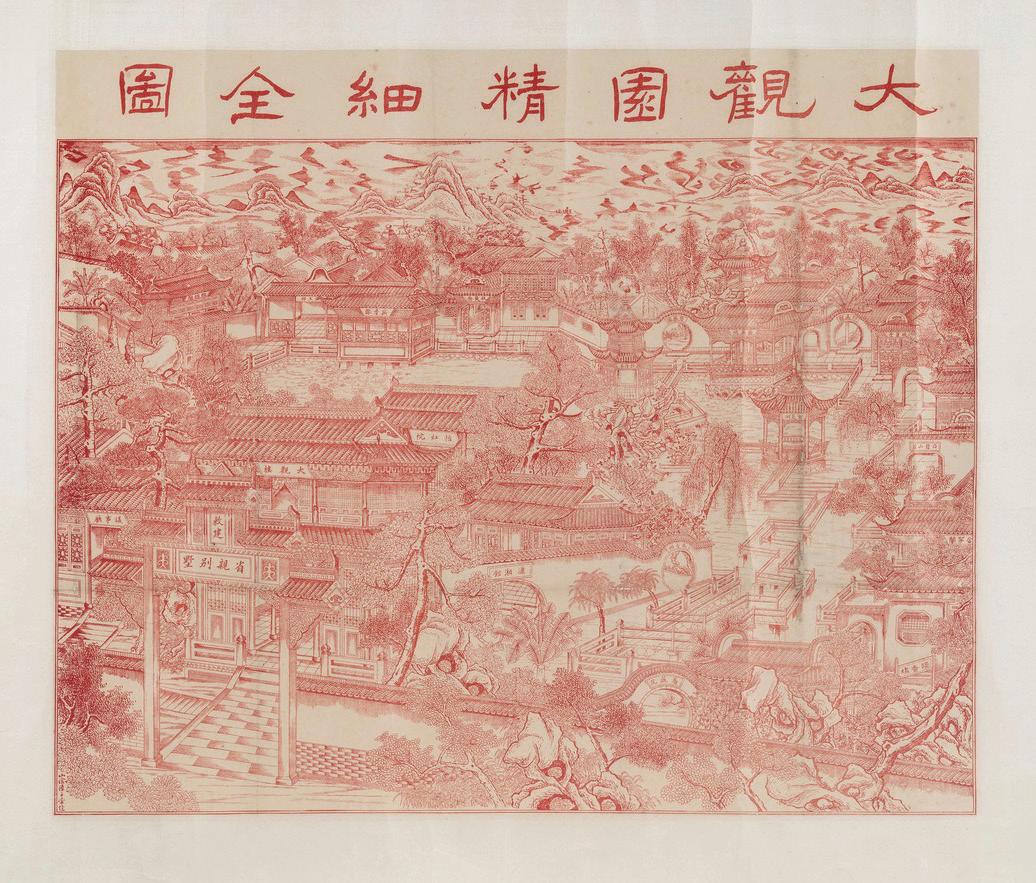
Bottom left Figure 5: Unknown artist. Hand-drawn Map of the Yuanmingyuan Imperial GardenPalace, 1920. Three hanging scrolls; ink and color on paper; Princeton University Art Museum, Gift of the P. Y. and Kinmay W. Tang Center for East Asian Art
Bottom right Figure 6: Celebrating 20 Years: P. Y. and Kinmay W. Tang Center for East Asian Art
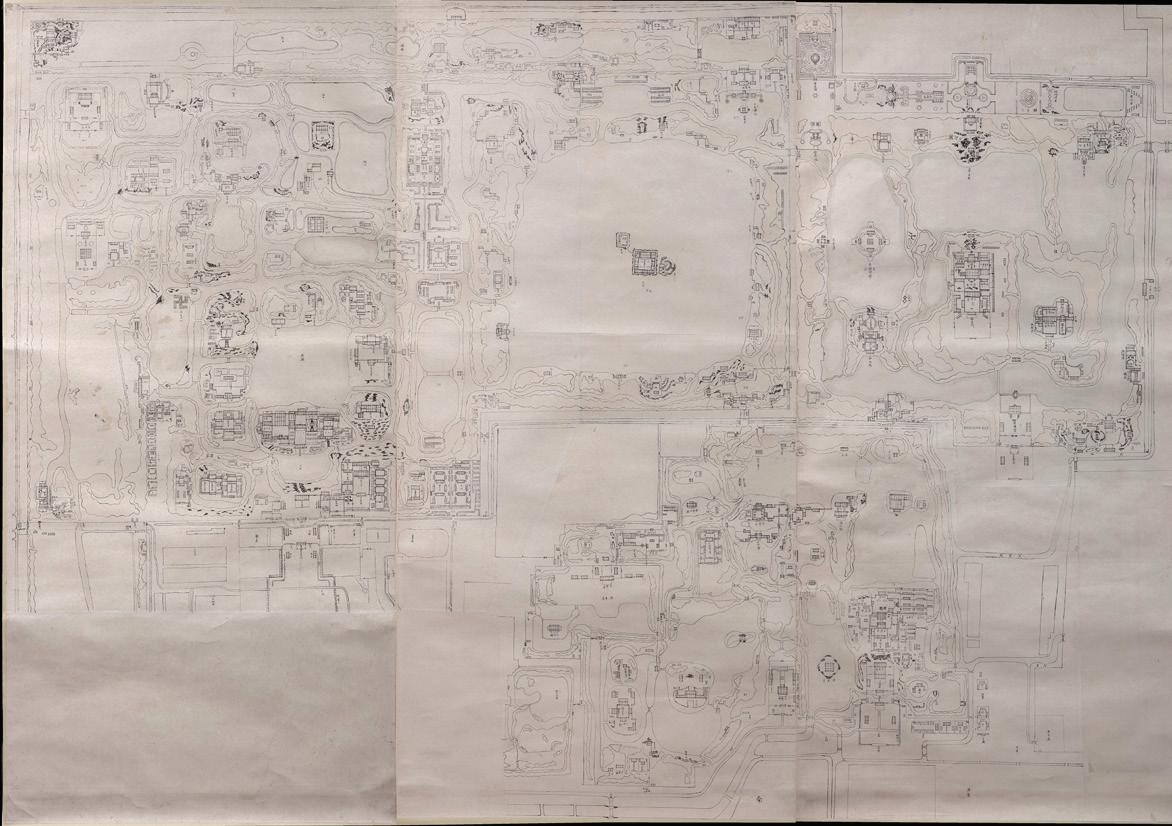
The return of Index staff to campus in August 2021 brought a gradual but very welcome return to hybrid and in-person Index events, including scholarly conferences, Index workshops, class visits, and research consultations. Researchers and graduate students now visit our temporary reading room in Green Hall 2C-10, where in addition to consulting files, they can take advantage of the study space and books of the Index library. Regardless of campus access, Index staff have continued fielding research inquiries in a variety of forms: since July 2021, they have responded to 82 queries in person, via email, through social media, and by phone.
In addition to welcoming researchers, Index priorities this year included upgrades to the online database, targeted online cataloging of the print backfiles, the resumption of in-person class room visits and scholarly events, and the timely publication of the journal Studies in Iconography and the Signa book series. A major database improvement targeted user accessibility, aligning with the University’s commitment to making digital resources accessible to a
wide range of people. Partnering with Perkins Access and Luminosity LLC, technology manager Jon Niola oversaw a four-month upgrade that included new metadata fields for alternative text descriptions, color contrast improvements, new code to support the use of screenreaders, and training editorial staff to add alternative text to images.
To advance backfiles cata loging, Index staff targeted the gold glass and ivory objects, with the goal of cataloging and archiving the print photos for at least four of the Index’s original “Medium” group ings before the next office move in 2024. This effort yielded some dramatic finds, including 1930s photographs and little-known prov enance for works of art that were lost or damaged in World War II and the Spanish Civil War (Figures 1 and 2). These historic records are now available online, with more added continuously.
The Index hosted or cohosted two conferences this year, both in hybrid format. At the annual Index conference “Fragments, Art, and Meaning in the Middle Ages,” held on November 6, 2021, seven distinguished speakers addressed the role played by fragments
and fragmentation in medieval and modern understanding of works of art (Figure 3). In January 2022, the Index cosponsored the hybrid “Power, Patronage, and Production: Book Arts from Central Europe (ca. 800–1500) in American Collections,” orga nized by art & archaeology faculty member Beatrice Kitzinger with Jeffrey Hamburger (Harvard University) and Joshua O’Driscoll (The Morgan Library & Museum) in conjunction with the Morgan’s exhibition Imperial Splendor: The Art of the Book in the Holy Roman Empire, 800–1500. Both events attracted a robust online audience, contributing to the decision to add a livestream component to future Index conferences, whether hybrid or fully in-person.
Index publications were only slightly delayed by the pandemic and supply chain issues. Volume 43 of Studies in Iconography appeared both in print and online; in addition to a wide range of book reviews, it includes articles on such topics as the monitory messages of Romanesque sculpture, women’s self-fashioning in devotional manu scripts, “failed” iconography in a late medieval Dominican altarpiece,
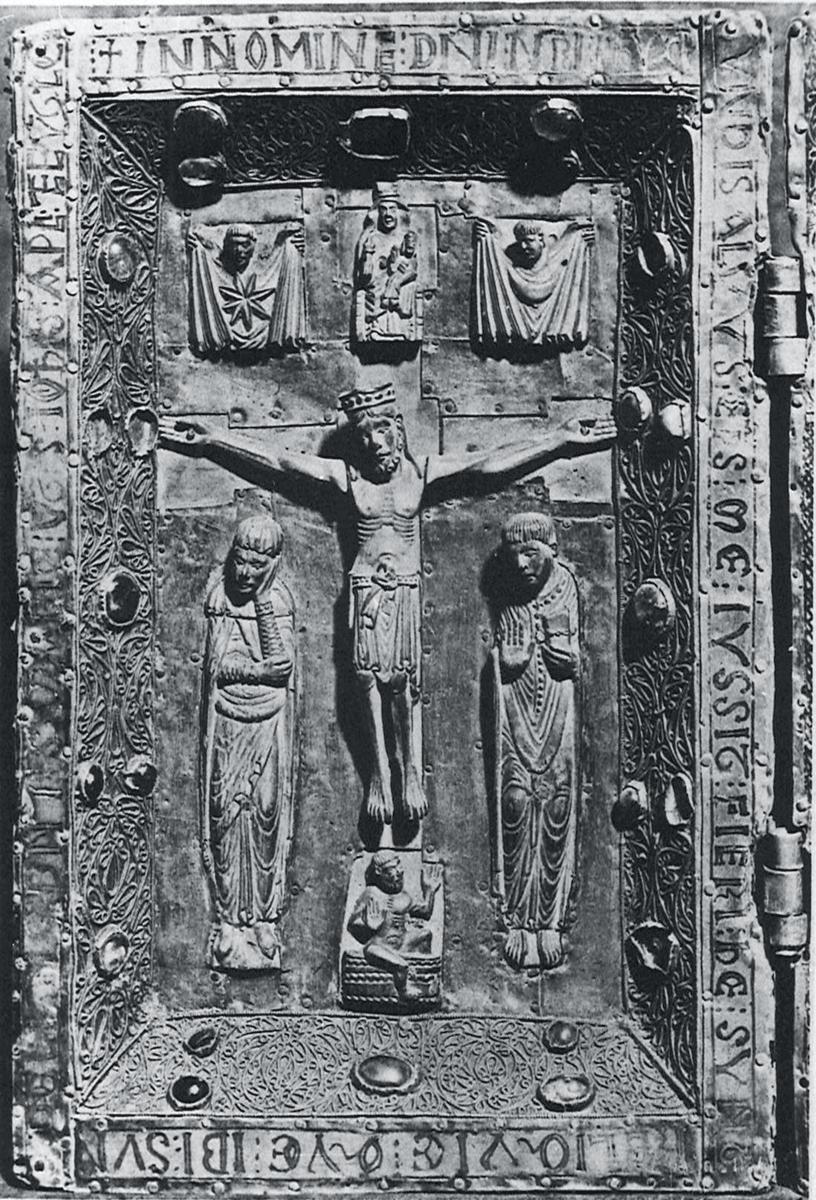

allegories of tyranny in Lucas Cranach’s painting, and a rethinking of Giorgione’s Tempest. May 2022 saw the publication of the second volume in the Index’s Signa book series, co-published with Penn State University Press. Iconography Beyond the Crossroads: Image, Meaning, and Method in Medieval Art, edited by Pamela A. Patton and Catherine A. Fernandez, sprang from a conference marking the 100th anniversary of the Index in 2017 (Figure 4). Its seven essays, which include a chapter by Beatrice Kitzinger, assess how current approaches to iconology and iconography break new ground in understanding the signification and reception of medieval images, both in their own time and in the modern world.
Most recently, the Index has undertaken a project to mitigate the threat that the Russian invasion of Ukraine poses to both medieval works of art and medievalist schol arship. With the support of a Flash Grant from the Princeton University Humanities Council, in fall 2022 Professor Julia Matveyeva of the O. M. Beketov National University of Urban Economy in Kharkiv will collaborate remotely with the Index to add print-only records of Ukraine’s medieval cultural heri tage to the online database (Figure 5). The project will preserve and present online archival images and metadata for key Ukrainian monu ments such as St. Sophia in Kyiv and St. Michael’s Golden-Domed Cathedral, as well as almost two dozen objects in Kyiv museums.
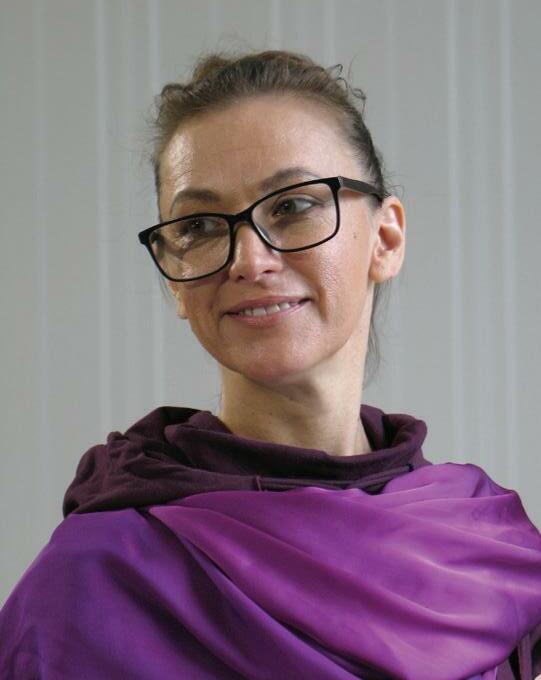
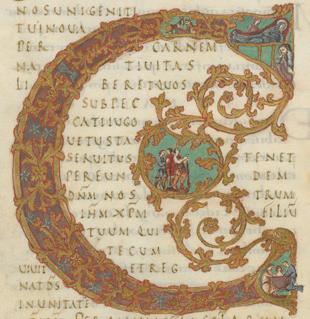

Top
Bottom
Bottom
tandem with virtual reality software (Figure 2). In the spring semester, Visual Resources presented lantern and 35mm slides as well as a stereoscope in Lucy Partman’s Art 106 class, “Looking Lab: Experiments in Visual Thinking and Thinking About Visuals,” and discussed the use of images and changes in media in the classroom.
Above Figure 1: Leigh Lieberman working in the field at the Punic-Romano city of Tharros on Sardinia. (Photo/The University of Cincinnati’s Tharros Archaeological Research Project)
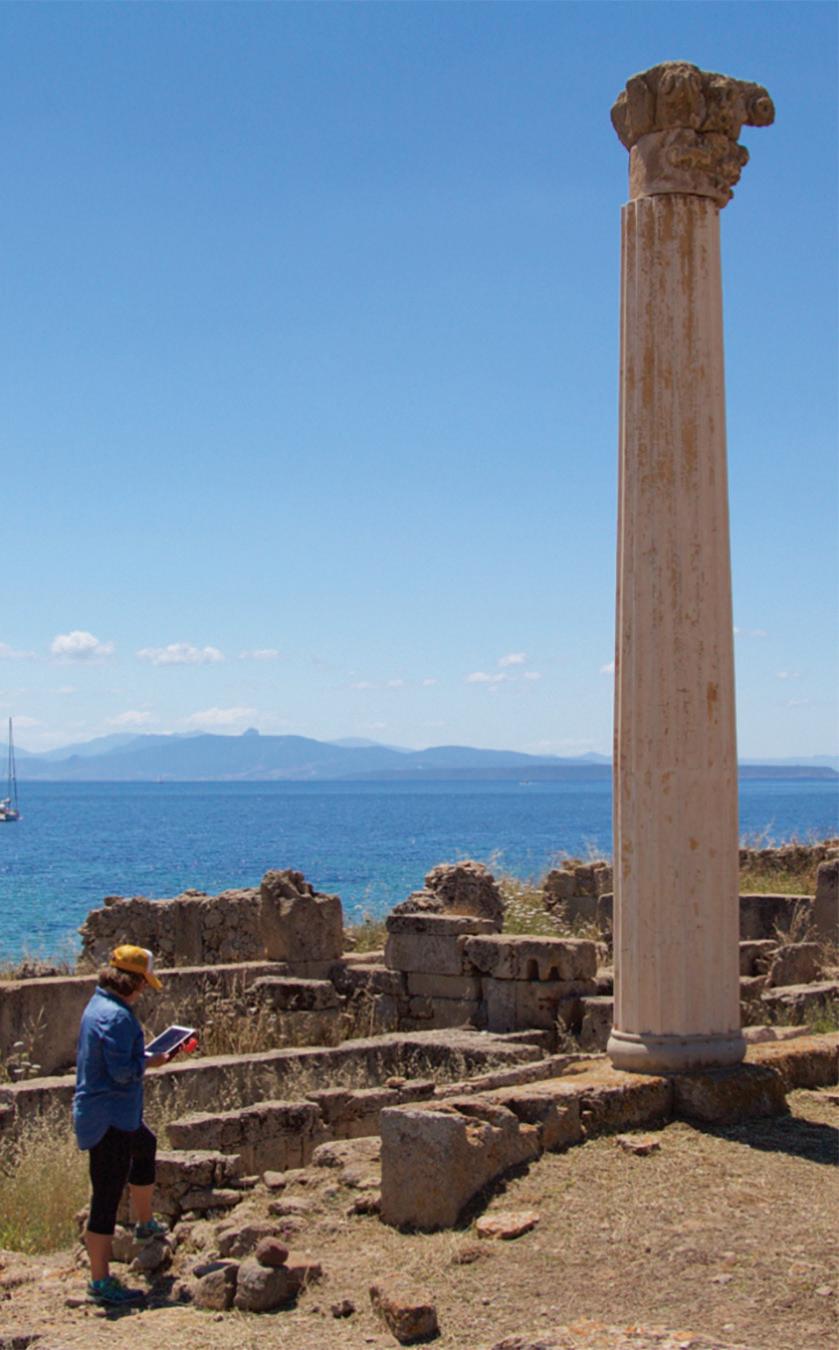
Right Figure 2: A comparison between lantern slide projection and virtual reality in Sam Holzman’s class. (Photo/Yichin Chen)
Over the course of 2021–22 Visual Resources held a candidate search for a new role to support digital projects through campus collab oration and individual consulta tions, while also advising on and instructing in new digital methods relating to art historical and archaeological scholarship. Leigh Lieberman *18, a familiar face to many in the department, filled the role in August of 2022 (Figure 1). Lieberman received her Ph.D. in classical art and archae ology at Princeton in 2018 and brings a wealth of knowledge and experience in archaeology, data management, digital humanities, and open access publication.
Throughout the year, Visual Resources demonstrated the history and breadth of the image collections by offering glass lantern and 35mm projection for several courses, and in one instance, with Professor Sam Holzman, in
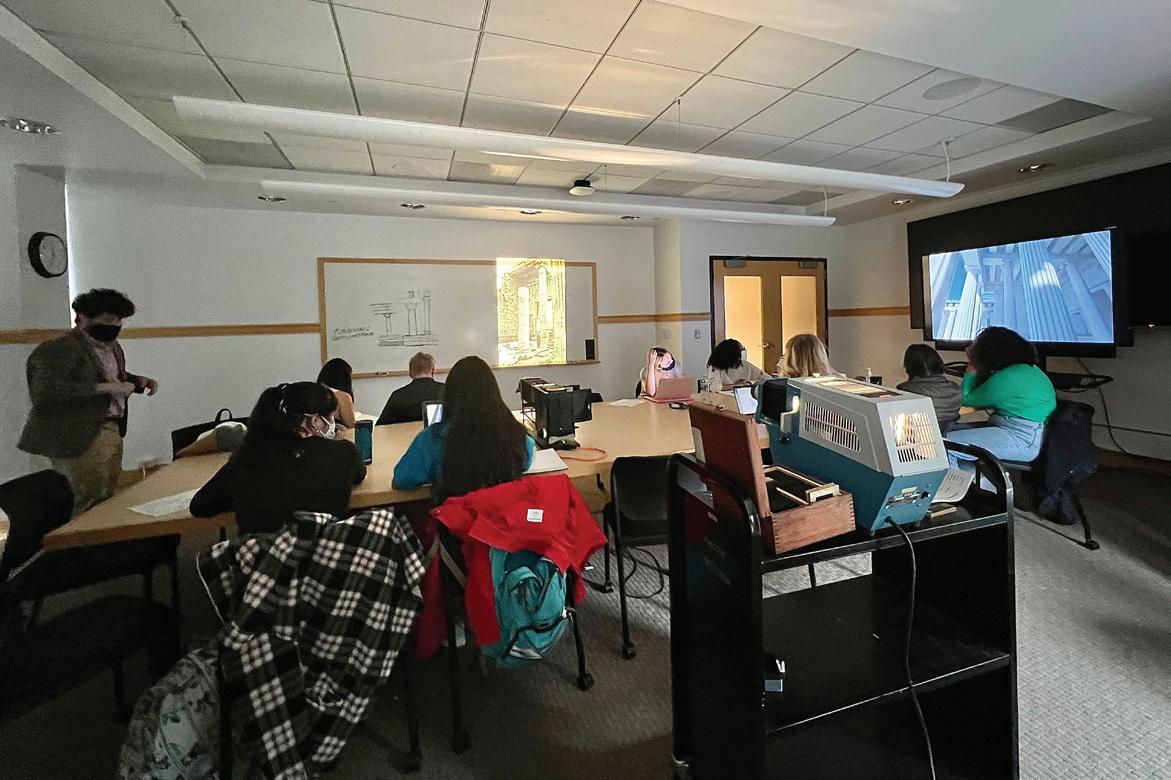
Visual Resources has accessioned two pottery sherd collections for teaching in the past year, one of Levantine pottery from the family of Reverend Orley Swartzentruber *70 who received them from former Princeton professor of religion Robert Balgarnie Young Scott, known as R. B. Y. Scott. The other, Roman and medieval glazed pottery sherds from the excavations of Antioch-onthe-Orontes, had been in storage at the Walters Museum of Art in Baltimore since 1949 (Figure 3). Professor Patricia Blessing has already put these to use in her class ART 401: “Introduction to Archaeology.” Having these mate rial collections available to students is particularly beneficial while the museum is closed.
In April, Iason Stathatos, Ph.D. student in the Princeton School of Architecture, consulted the Homer Thompson archive and presented
some of the collection in Holzman’s course ART 504: “Studies in Greek Architecture: Public Spaces.” Homer Thompson was a faculty member at the Institute for Advanced Study and is best known for his work at the Athenian Agora excavations with the American School of Classical Studies. In order to produce good quality images from these oversized drawings, Visual Resources secured the use of an additional room in Green Hall for John Blazejewski, senior staff photographer, to build the proper studio environment for oversized image capture (Figure 4). John is working to capture the rest of the Antioch drawings, of which only half have been photographed to date. Those of Daphne (Harbiye) will be prioritized in preparation for the forthcoming volume by the Committee for the Investigation of Antioch-on-the-Orontes to be published by Brill.
Visual Resources has settled into Green Hall and maintains its focus on learning new skills and offering services to better support the department curriculum and research. While located in McCormick Hall, Visual Resources rotated small exhibitions in the first floor hallway; in Green Hall, one large vinyl decal was installed instead on the stairway to the
second floor (Figure 5). Yichin Chen, East Asian cataloguer and digital support specialist is working with Michele Mazeris, senior cata loguer, to build a digital exhibition (puvisres.github.io/Lantern_Slides/) using an open source package called Collection Builder, which is freely hosted through Github. New digital projects will continue to be of interest to Visual Resources, though their sustainability remains a concern. Using static site devel opers like Collection Builder will allow Visual Resources to create small-scale, easily accessible and migratable projects in the future.
Visual Resources is also progressing with the digitization of a collection of historic lantern slides of Greece; undergraduate student
workers Jaylyn Murillo and Fariha Shoily and art and archaeology graduate student Katy Knortz have captured the images and data for about 1500 slides so far. (Figure 6) The project aims to complete 1500 images per year and to publish them online, free to download and use.
Senior Cataloguer Michele Mazeris continues to support faculty publications; this year she assisted Professor Charles Barber with image permissions for his forthcoming edited book with Maria Vassilaki, titled The Icon: An Introduction, to be published by Cambridge University Press (Figure 7). Summer 2022 brought researchers from the UK, Europe and Turkey to consult the Brünnow, Butler, and Antioch
archives (Figure 8). Visual Resources continues to build the department’s digital collections and increase the discoverability of these exceptional resources, while also supporting new methods of research.
Top left Figure 3: Teaching collection of sherds from the Antioch-on-the-Orontes excavation. (Photo/John Blazejewski)
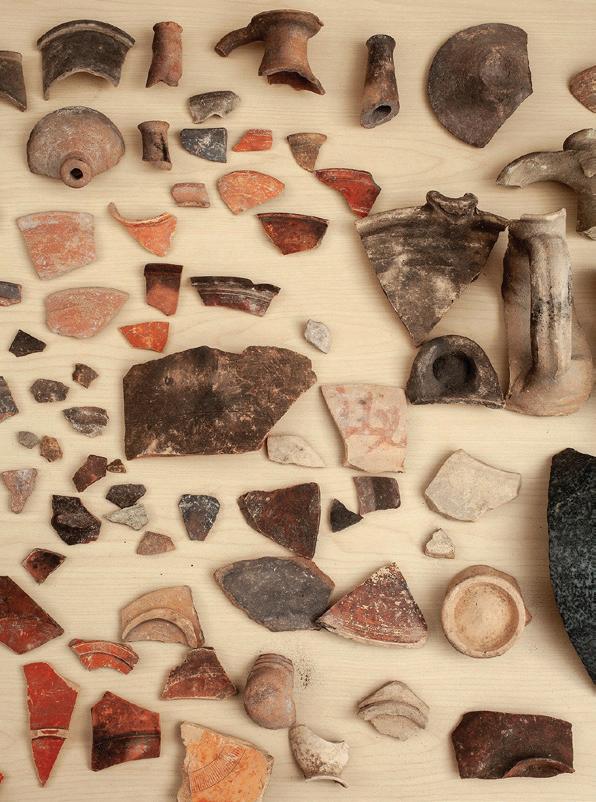
Top middle Figure 4: Proposed Agora Museum in Athens, sections looking North and West, by W. Stuart Thompson and Phelps Barnum, Architects, and William T. Aldrich Consulting Architect, July, 1947, Homer Thompson Archive. (Photo/John Blazejewski)
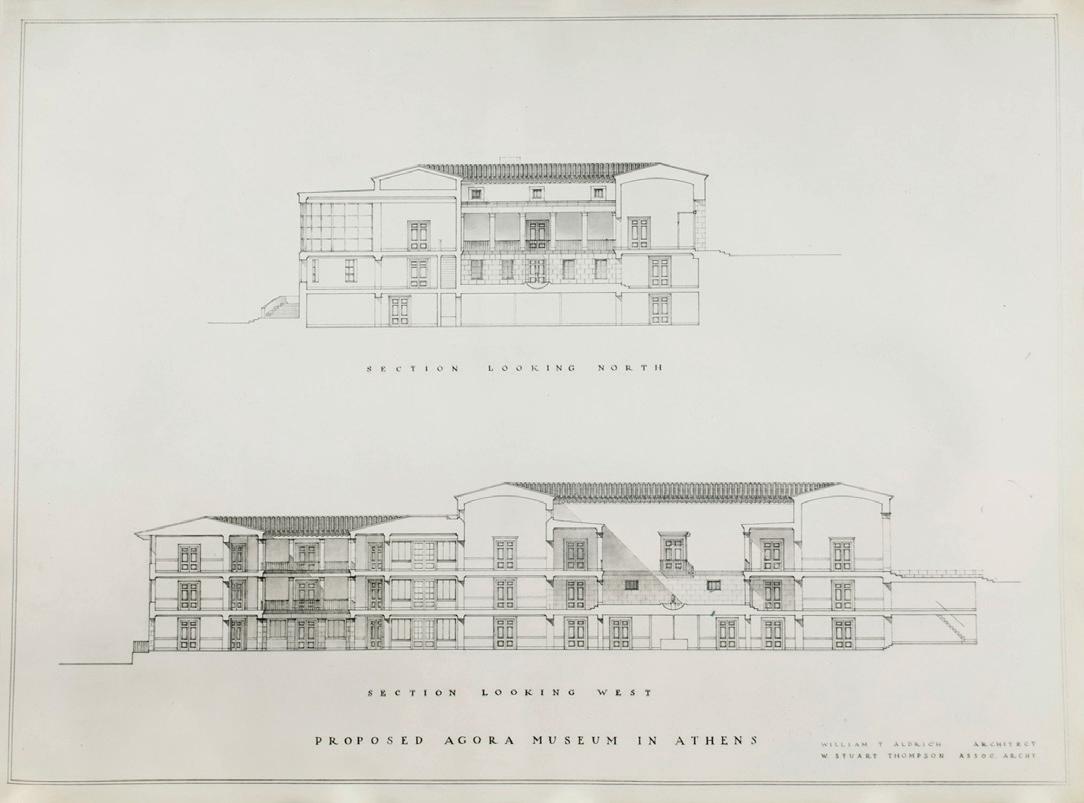
Top right Figure 5: Lantern slide wall decal being installed in Green Hall. (Photo/Yichin Chen)

Bottom left Figure 6: Acropolis, entrance to Grotto of Pan, Lantern Slide Collection
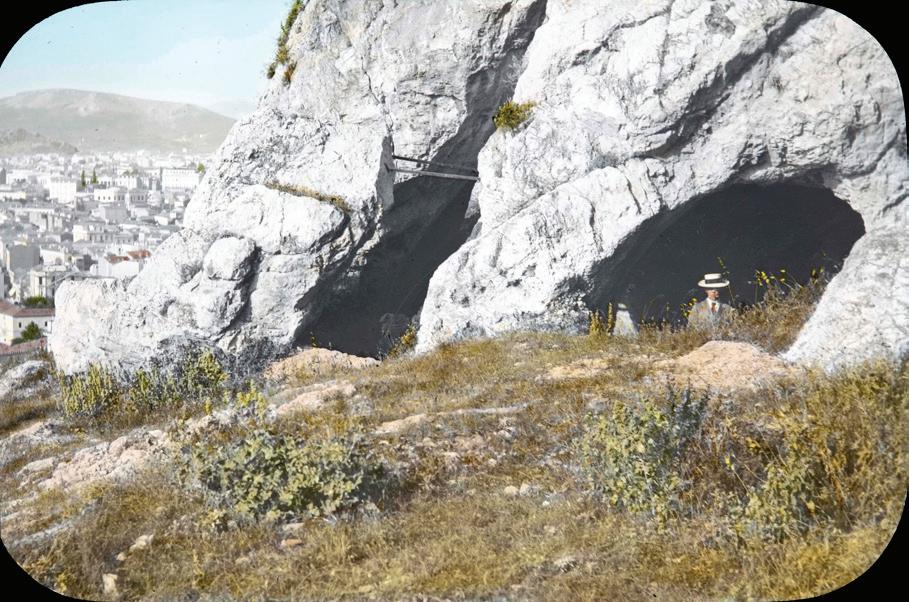
Bottom middle Figure 7: Icon of the Dormition of the Virgin, by Domenikos Theotokopoulos. Church of the Dormition of the Virgin, Ermoupolis, Syros
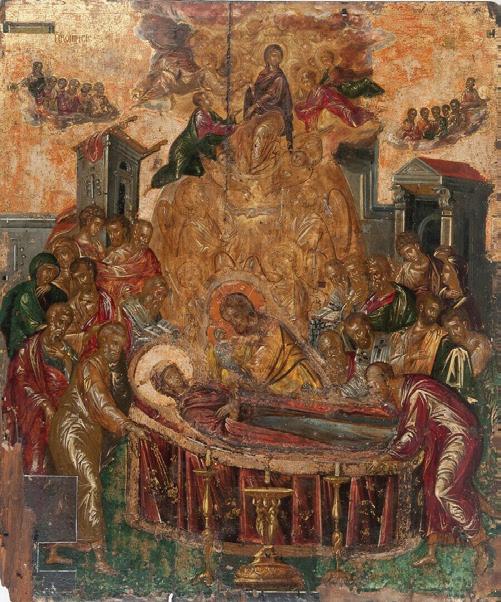
Bottom right Figure 8: Visual Resources Director Julia Gearhart (left) shows Professor Christina Luke (Koç University) an album from the Sardis Archives. (Photo/ John Blazejewski)
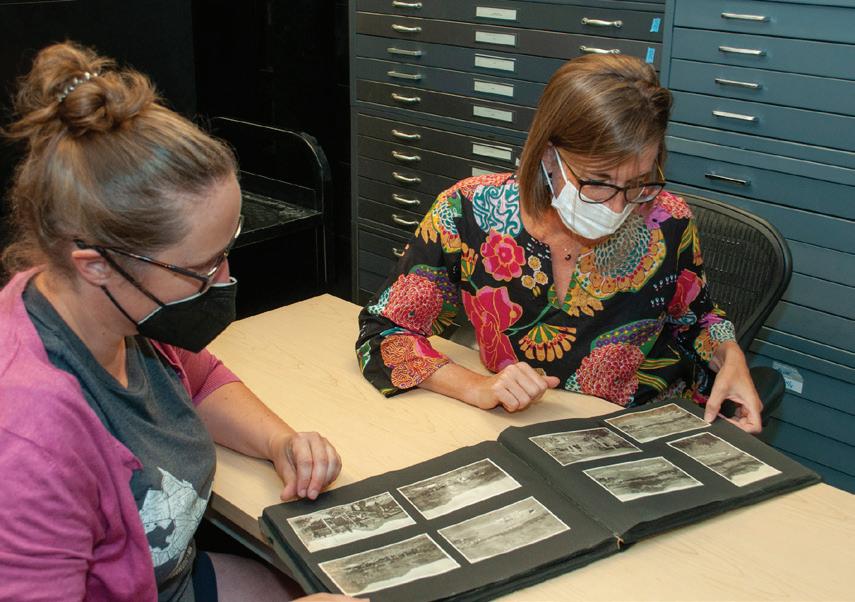
and Marquand Library moved forward on budget and on schedule for public opening in fall 2024. Summer 2021 marked the comple tion of the building project’s first phase, which proceeded entirely out of public view: the move of more than 65,000 works of art from the old Museum, on time and without damage (Figure 1). That effort was followed by work well visible to our campus neighbors and visitors: the dismantling of the old building, including the recycling of 95 percent of the materials therein. Excavation for the new complex began around Thanksgiving 2021 with steel rising just after the conclu sion of Reunions in June 2022.
Alongside the physical progress of the building project, a major focus in 2021–22 was planning for the galleries, exhibi tions, educational areas, and public spaces. Under the leadership of Museum Director James Steward and Chief Curator Juliana Ochs Dweck, curators have launched cross-departmental project teams to consider the many ways in which the Museum’s rich, globe-spanning collections can reawaken the past while being grounded in today’s needs, including evolving curricular
needs. Ideas of intersectionality, exchange, and contact—while continuing to recognize the useful roles that both chronology and geography can play—are emerging as key frameworks through which to launch new inquiries and thus to present and interpret objects in productive and often new directions.
Over the course of the year, Museum staff consulted with faculty and graduate students as well as outside experts. Grappling with issues ranging from presentation and interpretation to the ethics of collecting and display, collab orators reflected on changing art and history outlooks, the durable values of the humanities, galleries as spaces for coming together, the conjoining of excellence and equity, accessibility, transparency, and so much more. This phase of work is now being followed by a more inclusive and expansive commu nity- centered planning phase.
Despite not having a main building, the Museum continued to engage visitors with objectbased gallery experiences at two downtown Princeton locations: Art@Bainbridge, which reopened in September after COVID-19
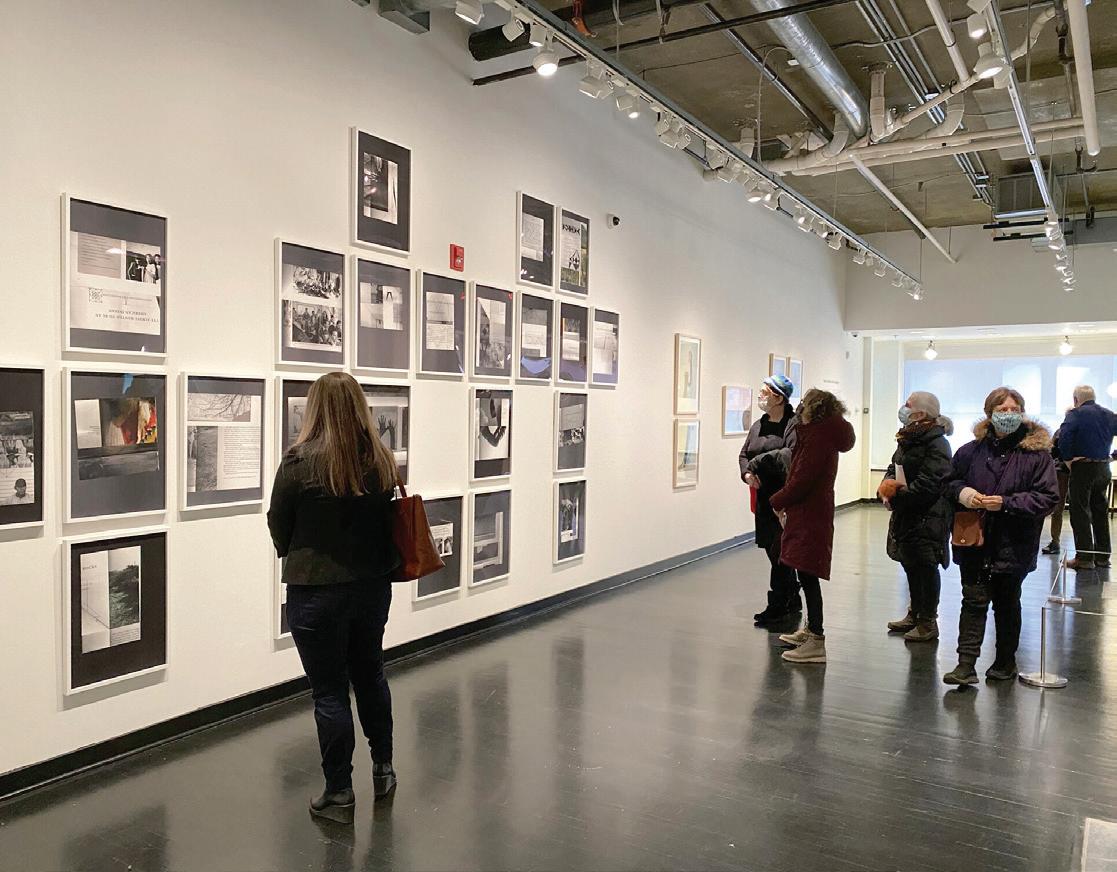

Top Figure 1: View of an Art Museum gallery as works are prepared to be de-installed for the Art Evacuation project.
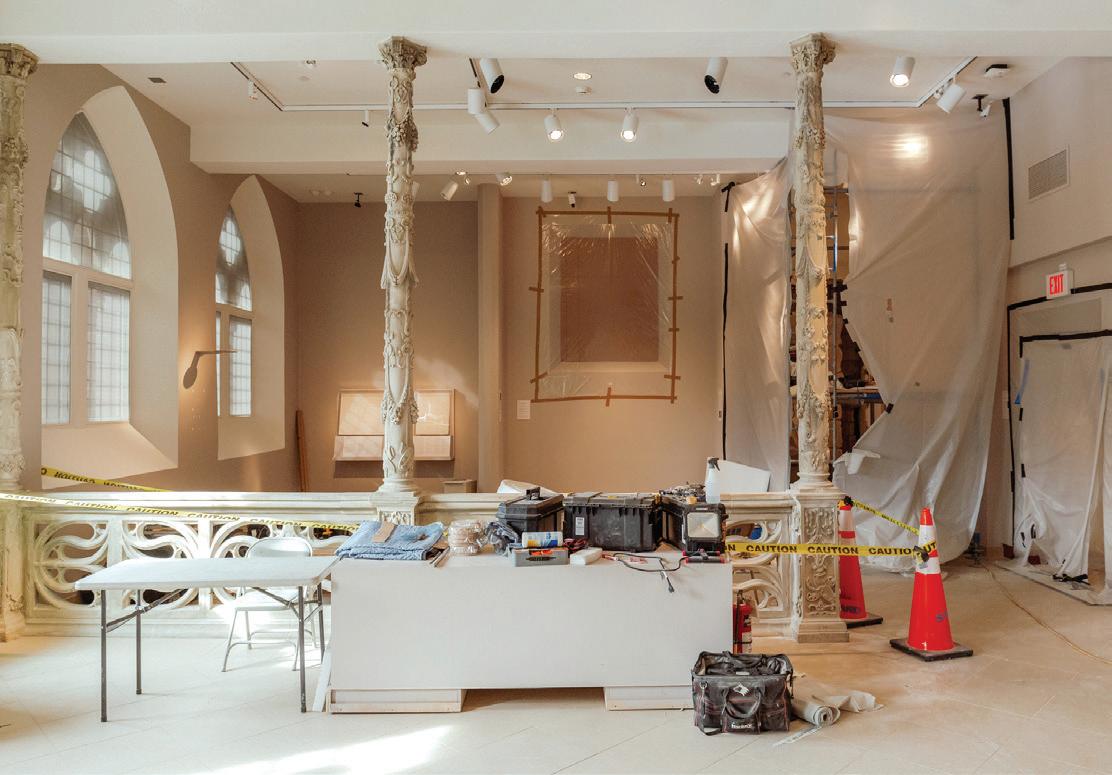
(Photo/Emily Askey)
Above Figure 2: Princeton University Preparatory Program (PUPP) Scholars visit Screen Time at Art on Hulfish for a closelooking gallery activity and an artmaking activity related to the exhibition.
(Photo/Kristina Giasi)
Right Figure 3: Visitors attend the opening of Native America: In Translation, curated by Wendy Red Star at Art on Hulfish.
(Photo/Kristina Giasi)
In a year marked by both the antici pated and unanticipated disruptions of operating without a building and navigating evolving pandemic restrictions, the Art Museum thrived. Reflecting the tireless creativity and collaboration of the entire staff and an extensive network of University and community partners, the Museum advanced its mission of serving today’s communities even as it advanced the groundwork for serving future generations of Princetonians.
Most critically, construc tion of the complex to house the new Museum as well as the Department of Art & Archaeology
Left Figure 4: Professor Andy Watsky teaching ART 425 / EAS 425 with Japanese prints. (Photo/Kristina Giasi)
Right Figure 5: Chief Conservator Bart Devolder discusses a painting with students of Professor Steve Benton’s physics course. (Photo/Kristina Giasi)
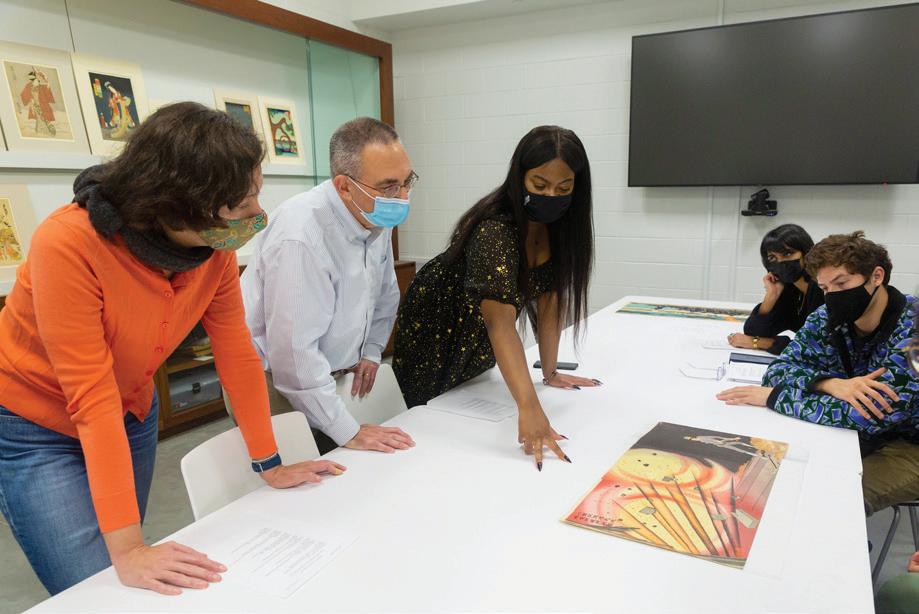
closures, and Art on Hulfish, an entirely new space that opened in December 2021 on north Palmer Square (Figure 2). In addition to serving as teaching venues for faculty and students, these spaces maintain connections with the larger community. Highlighting two exhi bitions from a roster of nine for the year, Gathering Together / Adama Delphine Fawundu explored the passage of knowledge through generations and throughout the African diaspora and Native America: In Translation, curated by artist Wendy Red Star, gathered work by Indigenous artists who consider the complex histories of colonialism, identity, and heritage (Figure 3).
Beyond exhibitions program ming, the Museum staff taught and supported Princeton faculty in teaching 2,964 students in 297 University classes (77 different courses) led by 63 professors and preceptors from 39 departments and programs in the direct inves tigation of objects from within the Museum’s collections. With the return to in-person instruction in fall 2022, the Museum launched two interim spaces for teaching from objects at Firestone Library and at the offsite classroom. Art and archaeology faculty were integral in shaping these spaces and deter mining which works of art would be most essential to their teaching and
the research needs of their students (Figures 4 and 5).
After a pandemic period of Zoom-only programs, the Museum offered both in-person and online events, expanding new digital participants while also engaging on-campus audiences both at campus venues and in the Museum’s two downtown galleries.
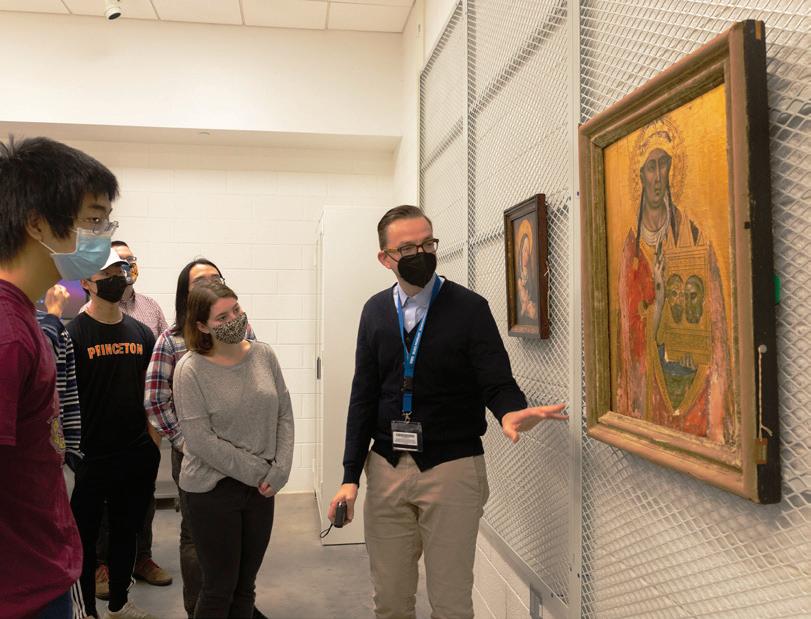
Over 10,000 participants from across campus and around the world joined in these often hybrid programs. Speakers included Mexican multimedia artist Teresa Margolles, the Museum’s 2022 Sarah Lee Elson, Class of 1984, International Artist-in-Residence; artist Alan Michelson, a Mohawk member of the Six Nations of the Grand River; and Steven Naifeh ’74, Pulitzer Prize-winning author of Van Gogh and the Artists He Loved.
The Museum continued to make acquisitions, reflecting its commitment to scholarship and impact across multiple audiences. One example is Aquilla (beaker), previously known as the “Cup of Montezuma,” an exceptional small drinking cup from 1400–1530, Peru, valuable as a rare example of Chimú goldwork with links to both sides of the Atlantic (Figure 6). Fulfilling a long-held collecting need, another example is the oil sketch by Sir Peter Paul Rubens entitled The Abduction of Ganymede, which provides a
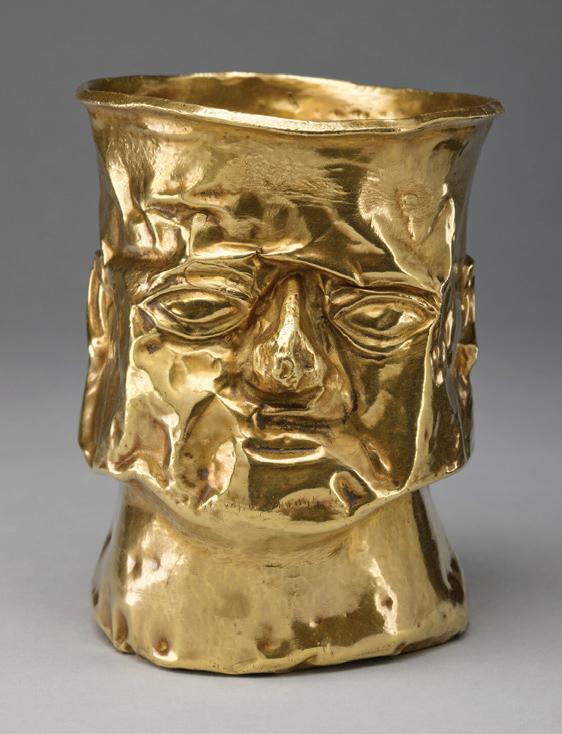
powerful foil for the Museum’s large Rubens painting, Cupid Supplicating Jupiter (ca. 1611–15), and will anchor a forthcoming Rubens course and exhibition.
Finally, among many new hires, the Museum has made three essential curatorial appointments. Two of these fill positions made vacant by the retirement of longserving curators Betsy Rosasco and J. Michael Padgett. Alexandra Letvin has joined the Museum as the inaugural Duane Wilder, Class of 1951, Associate Curator of European Art, with a Ph.D. from Johns Hopkins University and curatorial work most recently at the Allen Memorial Art Gallery at Oberlin College. Carolyn Laferriere began work at the Museum as curator of ancient Mediterranean art, building on a recent postdoctoral fellow ship at the University of Southern California, and completion of her Ph.D. at Yale University. Princeton Ph.D. Perrin Lathrop *21, a former student of Chika Okeke-Agulu, has been named the Museum’s first curator of African art for an initial two-year term appointment. These three important additions to the Museum team, along with the appointment of Elena Torok as the first objects conservator and an ongoing search for a second curator of prints and drawings, help assure that the Museum is poised for the growth ahead.
Figure 6: Late Chimú (or Inka), Late Intermediate to Early Horizon, A.D. 1400–1530, Peru, Aquilla (beaker). Museum purchase, Fowler McCormick, Class of 1921, Fund (2021-116). (Photo/Emile Askey)
Bridget Alsdorf Anna Arabindan-Kesson
Nathan Arrington Charlie Barber
Basile Baudez Patricia Blessing
Rachael Z. DeLue Brigid Doherty Hal Foster
Samuel Holzman Thomas DaCosta Kaufmann
Beatrice Kitzinger Michael Koortbojian Carolina Mangone Anne McCauley Chika Okeke-Agula Irene Small Deborah Vischak
Cheng-hua Wang Andrew M. Watsky Carolyn Yerkes
Lecturer with Rank of Professor Yve-Alain Bois James Steward

Tina Campt Pierre Terjanian Researchers
*Dora Ching
*Catherine Fernandez
*Janet Kay
*Lucy Partman Pamela Patton
*AnnMarie Perl Maria Alessia Rossi
Jessica Savage Henry Schilb Nicola Shilliam Justin Willson
*Also Lecturer
Desmond Kraege, Postdoctoral Research Fellow
Riccardo Pizzinato, Visiting Fellow
Ronni Baer Bryan Just Caroline Harris Zoe Kwok Alan Stahl Veronica White
Administrative Staff Department Office Julie Angarone Stacey Bonette Mo Chen
Marilyn Hansen Maureen Killeen Joanna Kovac Gina Migliaccio
Index of Medieval Art Fiona Barrett
John Blazejewski Jon Niola
Visual Resources
John Blazejewski Yichin Chen Julia Gearhart Michele Mazeris
Isabella
Photo by Zohar Lavi-Hasson
Vivan
Copyright © 2022 by The Trustees of Princeton University Nondiscrimination Statement
In compliance with Title IX of the Education Amendments of 1972, Section 504 of the Rehabilitation Act of 1973, and other federal, state, and local laws, Princeton University does
the basis of age, race, color, sex, sexual orientation, gender identity or expression, religion, national or ethnic origin, disability, or status as a disabled or Vietnam era
in any phase of its employment process; in any phase of its admission or financial aid
or other aspects of its educational programs or activities. The associate provost is the individual designated by the University to coordinate its efforts to comply with Title IX, Section 504 and other equal opportunity and affirmative action regulations and laws. Questions or concerns regarding Title IX, Section 504 or other aspects of Princeton’s equal opportunity or affirmative action programs, should be directed to Michele Minter, Vice Provost for Institutional Equity and Diversity, Princeton University, 205 Nassau Hall, Princeton, NJ 08544 or 609-258-6110. Further, inquiries about the application of Title IX and its supporting regulations may also be directed to the Assistant Secretary for Civil Rights, Office for Civil Rights, U.S. Department of Education.
 3S-2 Green Hall, Princeton, New Jersey 08544
3S-2 Green Hall, Princeton, New Jersey 08544